

How To Write a Scholarship Application Letter (With Template)
Scholarships provide crucial financial support for students pursuing higher education. A thoughtful, well-written application letter can help you make a compelling case to win a scholarship.
Key Takeaways:
- Tailor your letter to the sponsor’s requirements and highlight your relevant qualifications.
- Share details on your background, academic achievements, skills, goals and need for the scholarship.
- Use a professional format with clear organization and follow scholarship guidelines.
- Proofread carefully and have others review before submitting your letter.
Got No Time? A Quick Answer for You:
When writing a scholarship application letter, first review the requirements to understand what the sponsor is looking for. Introduce yourself and explain why you are applying in the opening. Discuss your relevant accomplishments, skills, goals and need for funding in the body. Conclude by thanking the committee and confirming your contact information. Use a professional format, proofread carefully and get feedback from others before submitting.
Let’s get started on crafting a scholarship application letter that showcases your unique strengths and passion. With a focused, engaging letter, you can increase your chances of securing funding for your academic journey.
What is a Scholarship Application Letter?
A scholarship application letter is a formal document where candidates can make a case for why they should receive academic funding from an institution, organization or individual.
The letter allows you to introduce yourself, share your background and interests, and highlight achievements and skills that make you deserving of the scholarship.
While specific requirements vary, application letters generally include:
- An introduction explaining who you are and why you want the scholarship
- Body paragraphs detailing relevant experiences, accomplishments, activities, and skills
- A closing inviting further discussion and providing contact information
The letter provides the opportunity to showcase your qualifications beyond what’s in your transcript and resume. A well-crafted letter can help you make a memorable impression and stand out from other applicants.
How to Write an Impressive Scholarship Application Letter
Follow these key steps when drafting your scholarship application letter:
1. Review the Scholarship Requirements
The first step is to closely review the scholarship requirements and organization’s website to understand what they are looking for in strong candidates.
Pay attention to:
- Eligibility criteria like GPA, field of study, etc.
- Mission and values of the organization
- Key attributes and qualifications they want applicants to highlight
This information will help guide what details you emphasize in your letter. You want to tailor the content to align with their priorities.
2. Craft an Engaging Introduction
The introduction paragraph is your chance to make a strong first impression. Include key details like:
- Your full name, field of study/major, and year in school (high school senior, college junior, etc.)
- Why you are excited to apply for this scholarship
- How the funding will support your academic and eventual career goals
This gives helpful context about who you are and why the scholarship is important to you.
Here is a sample introduction:
My name is Jennifer Smith, and I am currently a high school senior at Jefferson High School planning to attend Washington State University next year. I am very excited to apply for the Women in STEM Scholarship, which would enable me to pursue my dream of studying engineering and eventually designing renewable energy solutions.
3. Highlight Relevant Experiences and Achievements
The body paragraphs should focus on your strengths as a student and person. Think about the key attributes, accomplishments and skills you want to highlight that align with the scholarship requirements.
Be sure to provide concrete examples and anecdotes to back up the qualities you present. Don’t just say you’re a hard worker – describe your strong work ethic by listing related achievements.
Here are types of details to include:
- Academic achievements: GPA, honors, advanced courses, involvement in academic clubs related to your major.
- Extracurriculars: Leadership roles, sports teams, community service activities. Discuss skills demonstrated.
- Relevant work experience: Jobs and internships in your field of study. Explain what you accomplished.
- Unique skills and strengths: Language proficiency, communication/teamwork abilities, creativity, initiative, discipline, etc.
- Passion for your major/future career: When did you become interested? Share an experience that sparked your passion. Discuss future goals.
Ideally choose 3-4 focused paragraphs to make your case, rather than covering everything superficially. Quality over quantity.
4. Close With a Summary Statement
Wrap up your scholarship letter with a concluding paragraph that reiterates your enthusiasm and fit for the award. Thank the review committee for considering your application.
Also, include an invitation to contact you directly if they would like to discuss your application or request more information. Provide your:
- Phone number
- Professional email address
- Physical address (optional)
Here’s a sample closing paragraph:
Thank you for your time and consideration of my application. I am incredibly excited by the prospect of receiving the Women in STEM Scholarship and would love to further discuss my qualifications. Please feel free to contact me by email at [email protected] or by cell at 123-456-7890 should you have any questions. I look forward to hearing from you!
5. Proofread and Get Feedback
Before submitting your letter, be sure to carefully proofread for any errors or typos. Read the letter out loud to catch awkward phrasing.
It can also be very helpful to have mentors, teachers, and family members review your letter and provide feedback. A second set of eyes can catch issues you may have missed.
With these steps in mind, let’s look at a template and example scholarship letter to illustrate an engaging structure.
Scholarship Application Letter Template
Review this template when crafting your own scholarship application letter:
[Your Full Name] [Your Phone Number] [Your Email] [City, State]
[Scholarship Organization Name] [Contact Person Name and Title] [Address]
Dear [Contact Name],
Introduction paragraph: State your name, current grade/year in school, intended major, and why you want the scholarship. Share your academic and career goals.
Paragraph 2: Highlight your relevant academic achievements like GPA, honors, awards, and advanced coursework. Mention membership in academic organizations.
Paragraph 3: Discuss extracurricular activities and leadership roles that helped you develop important skills. Share related accomplishments.
Paragraph 4: Mention work experiences and internships in your field of study. Explain skills gained. Share what inspires your passion for your major and future career goals.
Conclusion: Thank the committee for considering your application. Provide your contact information and invite further discussion about your qualifications. Express your enthusiasm for the scholarship opportunity.
[Your Signature] [Your Full Name]
Scholarship Application Letter Example
Read this strong sample scholarship letter for a high school student applying to a local community organization:
Jennifer Smith 123-456-7890 [email protected] Springfield, MO
May 1, 2023
Springfield Women in STEM Scholarship Scholarship Committee 123 Main St. Springfield, MO 65000
Dear Scholarship Committee Members,
My name is Jennifer Smith, and I am currently a senior at Springfield High School who intends to study mechanical engineering at State University next year. I am thrilled to apply for the Springfield Women in STEM Scholarship, which would empower me to pursue my dream of becoming an engineer and innovator.
In high school, I have consistently maintained a 4.0 unweighted GPA while enrolled in multiple honors and AP courses. I am also deeply involved with the Robotics Club, serving as team captain for the past two years. In this leadership role, I have guided our team to win regional robotics competitions and demonstrate key engineering skills.
Beyond classes, I spend time volunteering as a tutor where I have helped dozens of classmates master concepts in math and physics. I also played junior varsity soccer freshman and sophomore year, developing my teamwork, discipline and communication abilities. Through these diverse experiences, I have become a driven, high-achieving student capable of excelling in a STEM degree program and career.
Most of all, I am deeply passionate about science, technology and using my skills to develop solutions to real-world problems. I have known that engineering was my calling since I built my first robot in 7th grade. Coming from a family of engineers, I have long been fascinated by renewable energy and want to help shape future green technologies. Receiving your scholarship would enable me to actively contribute to progress in this field.
Thank you for your consideration of my application. I can be reached any time at 123-456-7890 or [email protected] to further discuss my qualifications. I truly appreciate you taking the time to review my letter, and I hope to join the next class of women in STEM you support.
[Signature] Jennifer Smith
The Key Elements of a Strong Scholarship Letter:
- Customized Content: Tailor your letter to the specific scholarship requirements. Highlight the most relevant parts of your background.
- Well-Organized Structure: Use a professional format with logical flow between paragraphs. Easy to follow.
- Personal Details: Share information beyond just academic stats, like your interests, goals and financial need.
- Polished Writing: Avoid errors. Use clear, concise language that engages the reader.
- Attention to Details: Follow all scholarship guidelines precisely. Confirm eligibility. Submit by deadlines.
Pro Tips for an Exceptional Letter:
- Start early – Give yourself plenty of time to draft and refine your letter. Don’t wait until the last minute.
- Be positive – Avoid sounding desperate. Be gracious and focus on your qualifications rather than just need.
- Express passion – Let your enthusiasm and ambition shine through. Committees want motivated students.
- Proofread meticulously – Carefully check for any spelling, grammar or formatting errors.
- Get feedback – Have teachers, parents and friends review your letter before submitting.
- Send thank you notes – Follow up with thank you notes to show your appreciation.
FAQs About Scholarship Letters:
How long should a scholarship letter be.
There is no standard length – Scholarship letters can range from one to several pages depending on the requirements. Aim for 1-2 pages in most cases. The key is quality over quantity.
Should I send separate letters for each scholarship?
Yes, send customized letters – Avoid submitting the exact same generic letter for different scholarships. Tailor each one.
How do I list community service on a scholarship letter?
Highlight relevant activities – In a paragraph or bullet points, list service projects and how they allowed you to develop useful skills. Quantify hours served when possible.
Can I submit a scholarship letter by email?
Follow the guidelines – Some scholarships want printed letters while others accept email submissions. Carefully check and follow the requested method.
Is a scholarship letter the same as a personal statement?
They are similar but serve different purposes – The personal statement is for college admissions, while the scholarship letter is for financial award consideration.
In Conclusion:
A thoughtful, focused scholarship application letter allows you to introduce yourself beyond transcripts and resumes and make a compelling case for funding. By tailoring your content to the specific organization, highlighting your achievements and skills, and infusing passion throughout, you can craft a memorable letter.
Use the template and tips provided above to get started on your own application letter. Don’t underestimate the power of an engaging, personal letter to help you secure financial support as you pursue your academic and professional aspirations. With focus, planning and polish, your letter can get you one step closer to achieving your dreams!
Editor’s Note: Applying for scholarships can seem daunting, but breaking the process down into manageable steps will set you up for success. Remember to maintain a positive, gracious attitude and express genuine enthusiasm in your letter. Small personal touches and stories make a big impact. You’ve got this! 😊
With over two decades of experience, renowned scholar Dr. John Morris has become the #1 trusted global expert on winning prestigious government scholarships. Having personally received full funding awards from Germany, Brazil, Spain, the UK and Australia during his esteemed educational career, Dr. Morris now dedicates himself to helping disadvantaged students access the same life-changing opportunities through his motivational speeches at universities worldwide and highly popular Scholarships Office blog.
Similar Posts

10 Powerful IELTS Reading Tips for Sky-High Scores (Unleash Your IELTS Reading Potential)
Hey there, IELTS aspirant! If you’re reading this article, it’s probably because you want to conquer the IELTS reading test and achieve an impressive score. Well, you’ve come to the right place. In this comprehensive guide, I will reveal the top 10 IELTS reading tips that have helped countless students just like you to excel…

Australia Accredited Sponsors for 482 Work Visa Sponsorship (2023)
Getting a work visa for Australia can be a complicated process, but finding an accredited sponsor can simplify things greatly. In this comprehensive guide, we’ll cover everything you need to know about Australia Accredited Sponsors for 482 Work Visa Sponsorship in 2023. Key Takeaways: Finding an accredited sponsor is a critical first step for the…

From Unemployed in Lisbon to a $360K Boston Job in Under 15 Months: Ana’s Incredible Career Transformation
In our fast-changing job landscape, how does one go from being unemployed and seemingly left behind to landing a high paying role in a hot field like data analytics or engineering? That’s the inspiring question answered by Ingrid Norris’ journey from broke in Lisbon to a $360K salary in Boston in an astonishingly short timeframe….
How to Avoid Scholarship and Financial Aid Scams: The Ultimate Guide
Applying to college can be an expensive endeavor. Between tuition, room and board, books, and other fees, the costs can really add up. It’s no wonder that scholarships and financial aid programs are so appealing to students and families! 💸 Unfortunately, where there is need, scammers will find opportunity. Each year, thousands of students fall…

Australia Construction Visa Subsidy Program 2023 (Free Visa, Travel Cost)
Key Takeaways The Western Australian (WA) government has introduced an exciting new initiative – the Australia Construction Visa Subsidy Program 2023. This program provides grant payments to employers to support skilled migration and help fill demand for construction workers in WA. With the state’s housing market booming, the construction industry urgently needs to expand its…

How to Write a Winning Motivation Letter for the Erasmus Mundus Scholarship
Got No Time? A Quick Answer for you: The motivation letter is a crucial part of your Erasmus Mundus scholarship application. It allows you to showcase your accomplishments, competencies, goals and passion. Follow these key tips for writing an outstanding motivation letter: With careful planning and a compelling, personalized letter, you can maximize your chances…
Leave a Reply Cancel reply
Your email address will not be published. Required fields are marked *
Save my name, email, and website in this browser for the next time I comment.

How to Write a Good Scholarship Application Letter (6 PDF Sample Examples)
Published: 09 Sep 2020 Scholarship Application 188,999 views
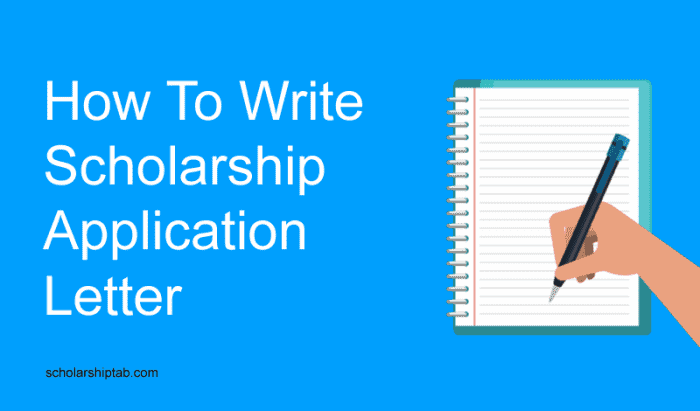
Are you uncertain about how to write a scholarship application letter? You are in the right place. We will teach you how to write a killer scholarship application letter. Over 6 PDF application letter sample examples available for download. After examining the scholarship cover letter, we will then check out some scholarship letter samples.
We will discuss
- What is a scholarship application letter?
- Parts of a scholarship application letter
- Scholarship Letter Format
- What not to include in a scholarship application letter (Scholarship cover letter)
- Sample Application Letter for scholarships
- Scholarship Application Letter sample pdf
- Scholarship Application Letter samples Templates
Application Letter for Scholarship in College
Application to principal for grant of scholarship.
- Application Letter for financial need
- Application letter for master's degree
- Application letter for university
Checkout ongoing scholarships for internation students to study abroad
WHAT IS SCHOLARSHIP APPLICATION LETTER
So, a scholarship request letter is a cover letter that indicates your interest in a scholarship and ways in which the award would help you achieve personal and professional goals. It is a letter requesting scholarship consideration.This type of letter is usually required along with other important documents by the University committee. The purpose of the scholarship application letter is to convince the committee that the candidate in question is highly eligible for the award. It is an instrumental tool in seeking financial backing. Further in this article, you will encounter scholarship application letter sample ad hoc. Checkout best way to apply for scholarships and get taken
PARTS OF A SCHOLARSHIP APPLICATION LETTER
As you must have seen in other articles , documents such as a scholarship essay or scholarship CV are drafted with caution, organization and professionalism. A scholarship application letter is not an exception. In order to capture the attention of the committee deeply, a scholarship application letter must be written in a well - structured manner. An application letter for scholarship pdf will be provided (scholarship cover letter pdf). The following parts make up an appealing scholarship application letter:
Contact Information
Self introduction and a milestone achievement.
- Middle Part
- Key details of you and reason why the committee should choose you
- Expression of passion and reason why you want the scholarship
- Call to action paragraph
- Best Regards
Just as every formal letter contains the contact information of the sender and the receiver, the same applies here. A scholarship application letter should contain the name, street address, telephone and email of the sender (at the right side). Afterwards, the name of the organization, street address and zip code are placed on the left side when writing an application for scholarship request
First impression matters a lot and so is the first paragraph of a scholarship application letter. The first paragraph should indicate your zeal and your understanding of having such an award. It would whet the appetite of the reader. Start with a significant achievement that shows how much you value this particular course of study.
Key Details about Yourself and reasons for Choosing you.
A scholarship cover letter for students should entail relevant information about your achievements, the role models you look up to, your struggles to attain the scholarship and the victory you would achieve for getting this scholarship.
Expression of your passion
In this paragraph, the committee wants to encounter the zeal in attaining the scholarship and perhaps the sacrifices you must have made. This doesn't mean that you want to sound desperate. But you are expected to express how much you want the award in a constructive manner.
Call to action
In a letter to scholarship committee, a call to action paragraph is the last but not the least important. Do you want the committee to call you back? Then you just have to say it. Ask for a meeting arrangement and leave the notable impression that you have more to discuss.
LETTER FORMAT FOR SCHOLARSHIP APPLICATION
Let's reiterate a point here. The content of the letter is as important as the structure of the letter. This means the format has to be set in a way that makes the content edible and appealing. It can also serve as a scholarship letter format for school. So how about you follow the few guidelines below:
- Use the correct spacing: 1 or 1.5.
- Don't be tempted to use justification. Left side align is easy on the eye.
- There should be one - inch margins for some white space and friendly impression.
- When it comes to the paragraph, there should be double spacing between them.
- Fonts like Calibri, Arial and Times New Roman are welcome.
WHAT NOT TO INCLUDE IN A SCHOLARSHIP APPLICATION LETTER
To be more certain that you write only within the context of what is needed, here are some traps you just avoid.
1. Don't include your weaknesses
This is an opportunity to zone in your main strengths, achievements and skills. This is not the stage where you explain your weaknesses. Just like the example of letter of intent for scholarship below, focus on matching your strengths with some vivid examples.
2. Don't use an informal tone.
In the process of appealing one's heart, you may want to shift to an informal tone. That shouldn't happen. Your letter has to be precise, clear and formal. The scholarship letter examples below will give you a hint
3. Don't submit without proofreading
In a letter of interest for scholarship, it is essential that you check for grammatical errors and rectify them. One way you can achieve that is by asking someone to read the letter. That way you will have a more objective viewpoint.
4. Don't add unnecessary information.
You may find yourself adding unnecessary details that would only make your letter sound lethargic and unappealing. True, it is a personal letter for scholarship. However, details such as height, family tree or any other irrelevant information should be avoided.
5. Don't hide your need for financial assistance.
You may conclude that expressing your inability to pay tuition fees would sound desperate. Wrong! A scholarship is meant to alleviate a financial burden. So asking for financial assistance is highly expected. So an application letter for scholarship financial assistance is just appropriate. Relate your strengths and academic achievements. In the middle part of the scholarship application letter, you are free to explain how beneficial the organization's financial assistance would be to you.
Checkout how to get scholarship to study abroad
EXAMPLE OF APPLICATION LETTER FOR SCHOLARSHIP
Here is a sample scholarship application letter.
Mary Rowland
23, Streetview, Los Angeles,
California, USA,
[email protected]
+565 325 36771
7, September 2020
Admission Board,
Quebec University,
Lilyland Park,
Quebec, Canada
Dear Admission Officer,
I can't imagine any better opportunity to further my career in Marine Biology than this. So I am applying for a scholarship award for Masters in Marine Biology in the University of Quebec. This would be an added achievement to my victory in a 200 member school competition for Marine Biology. This would testify to my fervor for this field of study.
Ever since I was a kid, my parents would take me to all sorts of aquariums. Every time was a fascinating experience. But going back home never stopped my curiosity. I kept researching the nature and functionality of sea creatures. In time, I developed research and analytical skills, critical thinking and problem solving skills. Once, there was an elevator pitch competition with the title "The Impact of Whales in the Lives of Scuba divers". The topic sounded amusing and daunting at the same time. But my passion for Marine Biology never stopped me from giving it a shot. At the end, I was applauded for my great speech. In time, my presentation skills were furnished.
So shortlisting me for the scholarship award would be a privilege on my part as it would reflect on my grades, courseworks and projects.
Understanding the nature of sea animals and plants has propelled me to draw closer to high school students who are equally curious and craving for answers. So I took up full time as an aquarium tour guide. With this job, I shared my passion and enjoyed the satisfaction that pupils had after an interesting tour. However, my job provides a meager income. As much as I aspire to study Marine Biology, I would need financial assistance to bring my dream to reality. Therefore, I am humbly seeking monetary support.
How about we hold a meeting and discuss the impact the course of study would have on the next generations and the facilities that University has to contribute to the exposure of Marine Biology as a discipline?
Best Regards,
Mary Rowland.
SAMPLE SCHOLARSHIP APPLICATION LETTER PDF
So the above section of this article entails a sample scholarship application letter. For faster accessibility, we would advise you to download the scholarship request letter sample PDF so as to fully be absorb every step that has been applied. Dowload Sample Scholarship Application Letter
SCHOLARSHIP APPLICATION LETTER TEMPLATES
You may have a more specific purpose in mind when writing a scholarship application letter. The purpose could be to gain admission in college or in University, appeal for a financial need or application for masters. In any case, here are the following templates and letter intent sample for scholarship and their sources.
Here is an application letter for high school
Download scholarship application letter for high school
Here is a request letter for scholarship from students
Download application to principal for grant of scholarship
Scholarship Application Letter for financial need
Here is a “reason for applying scholarship” sample letter.
Download scholarship application letter for financial need
Scholarship Application Letter for Master's Degree
Here is a sample scholarship application letter for masters degree scholarships
Download scholarship application letter for masters degree
Scholarship Application Letter for University
The last application letter for applying scholarship
Download scholarship application letter for university
Striving to get a scholarship is a great goal to set. So kudos to you. With guidelines, tips and samples in the article, you will have no other choice but to succeed. Also you have been provided with a letter requesting scholarship consideration pdf. So write an application letter for scholarship confidently. However, that would not be the end of the scholarship application process. You will definitely be asked for a scholarship interview and even a scholarship recommendation letter. In any case, ScholarshipTab has all the answers. Simply subscribe to our newsletter and have a good digest of scholarship application strategies. Till we meet again.
Latest Blog Posts
- Canada Work Visa Application Process
- Best MBA in USA 2024 - 2025
- H4 Visa Interview questions and answers (PDF for download)
- Online Masters in Psychology 2024-2025
- 26 Medical Schools In Canada For International Students
- 32 Artificial Intelligence Free Course With Certificate
- 20 MBBS In Abroad For Indian Students At Low Cost 2024
- 36 Best Fashion Schools In The World
- Best Scholarships
- DAAD Masters & PhD Scholarships for Sub-Saharan African Students 2024
- Leventis Foundation Scholarships 2024-2025
- University of Michigan International Student Scholarships 2024
- Brunel University London Life Long Learning Bursary 2024
- University of Stirling Karen Napier MSc Scholarship 2024
- Stephen Young Global Leaders’ Fully-funded Scholarship Program in UK 2024
- University of British Columbia Schmidt Science Fellowship program for Canadian and International Students 2024
- IHE Delft MENA Scholarship for African Students 2024
Scholarship Tips
Scholarships by country to study.
- United Kingdom
- United States
- South Africa
- Netherlands
- New Zealand
Scholarships by Category
- Postgraduate
- Undergraduate
- College School
- Entrepreneurs
- Bachelors Degree
- Women Scholarships
- Fully Funded
Scholarships by Country of Origin
- African Students
- Developing Countries
Scholarships by Institution / Company
- Flinders University
- German Academic Exchange Service (DAAD)
- University of Edinburgh
- Australian National University (ANU)
- The World Academy of Sciences (TWAS)
Scholarships by School
- University of Melbourne
- University Of Queensland, Australia
- University of Kent
- Monash University
- Privacy Policy
- Terms of Use
Scholarships
- Undergraduate Scholarships
- Masters Scholarships
- MBA Scholarships
- Ph.D Scholarships
- Fellowship Scholarships
- Fully Funded Scholarships
- F1 Visa Interview Questions And Answers
- Scholarship Application Letter
- Letter Of Intent For Scholarship
- Personal Statement For Masters
- Motivation Letter For Scholarship
- Scholarship Acceptance Letter
Other Locations
- Scholarships in UK
- Scholarships in Canada
- Scholarships for Nigerian Students
- Scholarships for African Students
- Study Abroad Community
- Scholarships
How To Write An Application For A Scholarship
- 6 minute read

- November 30, 2023
- No comments
Thinking of how to write an application for a scholarship? An essay is typically required for applicants for scholarships. Some, nevertheless, might request a cover letter or a letter of intent instead! prize letters aim to learn more about you and your reasons for deserving this particular prize, contrary to an essay or a letter you could write to a friend. This is a student’s guide on writing a scholarship letter!
To apply for financial aid and scholarships successfully and move toward a college degree without debt, you must submit a scholarship request letter. The contents of this letter, as well as the goal and final advantage of being a proactive scholarship applicant, will be explained in the parts that follow.
There is fierce rivalry among students seeking scholarships to attend college. They must apply for a scholarship, using the prescribed form, to the scholarship committee of their choice along with a cover letter that should serve as your letter of request for the scholarship. Often the only document that a committee sees, the scholarship request letter is the first thing they will see. They could not even glance at the application if the letter doesn’t impress them.
The letter requesting the scholarship needs to be precise and short. Among the hundreds of these letters that the scholarship committee will review, the ones that concisely and clearly articulate the purpose will stand out. Presenting oneself as a strong prospect for the scholarship is also crucial for the application. This indicates that they possess the necessary drive and initiative to use the funds wisely.
What is a Scholarship Application Letter?
An applicant’s letter to a possible scholarship provider is called an application letter. The letter’s goal is to make a financing request for educational costs. The letter needs to be written correctly and with no mistakes. It must also be brief and precise.
How To Write A Scholarship Letter As A Student
The secret to crafting a winning application is knowing how to effectively communicate your value by putting your life experiences on paper.
Try to remember the following advice as you write:
- List the noteworthy events that have shaped your life or helped you stand out from the crowd.
- Practice stating a few key points, such as the significance of these experiences and how they have impacted both you and other people.
- Decide what you want for yourself, Consider why this objective is important to you. Think about the impact your ambitions will have on the community.
- Think about relating your narrative to the prize. Should the scholarship be provided by a community-based organization, you could want to talk about how your contributions have helped and improved your neighborhood.
- To gain an idea of the tone and flow of your writing, try reading it aloud.
- Give it to a responsible adult or friend to get a second opinion on what works and what needs more investigation.
How to Write an Application Letter for a Scholarship
The formatting process is the first step in writing a scholarship letter. Try adhering to the conventional letter format! Start your paper by including your name, address, and phone number at the top, then the day this letter is being written. Next, include the recipient’s or organization’s contact details in the letter.
The salutation for your letter should begin with “Dear” followed by the recipient’s name. You can address them as “Dear Scholarship Committee” if you don’t know their name.
Put a closing comment at the end of your letter, like “Thank you for your consideration.” After that, sign your name! Typing your name beneath your signature is also advised.
What To Include In A Scholarship Letter
The committee should learn about your background and why you are a standout candidate from your scholarship letter. A letter can have a more informal tone than an essay. Here is an outline for the format of your letter!
- Hook: Hundreds of applications are frequently submitted for Hook Scholarships. With a hook, you want to make an immediate impression! Make it distinctive from the typical student experience and personable. Consider an intriguing opening line or a strong thesis statement that will draw the reader in and compel them to continue reading. Give the reader a brief overview of your “character” by stating what particular thing, person, or experience has shaped who you are now. It’s much better if you can connect your hook to the particular scholarship! This demonstrates your familiarity with the scholarship provider. For instance, you may talk about a time you worked with the Rotary if you’re applying for a scholarship offered by the local chapter of the Rotary Club. Alternatively, it might be mentioned on the organization’s website that they value innovation. You may talk about how your background in computing helped you develop into a creative community leader! In the end, your opening paragraph should highlight your motivation for wanting the scholarship and your suitability for it.
- Crucial Experiences: Typically, you will have one or two body paragraphs that highlight your qualifications for the scholarship after the opening paragraph. To achieve this, emphasize your experiences, abilities, and attributes concerning the scholarship requirements! One significant leadership or volunteer experience should be covered in each paragraph. Use the STAR structure to show off your involvement to the fullest!STAR is a 4-part acronym that will help you craft a strong paragraph describing a specific volunteer or extracurricular experience.
S — Situation (who, what, when, where)
T — Task (your objective)
A — Actions (what you did, how you did it, skills you used)
R — Result (qualitative or quantitative proof of your success)
Make sure to use this format in each body paragraph! Making use of this will enhance the impact and readability of your work.
Closing: Your influence and the reasons you’re the greatest candidate for the scholarship should be summed up in the final paragraph. It’s also a fantastic opportunity for you to elaborate on how the scholarship will benefit you. What academic objectives do you have? What are your aspirations for your career? How can this scholarship support your career goals? Lastly, express gratitude to the reader for their attention and time. If there are any more steps in the procedure (such as an interview, for instance), you can also ask them to get in touch with you!
To sum up, developing the ability to write a strong scholarship application is an essential talent that can have a big influence on a person’s academic path. Applicants can improve their chances of making an impression on the decision-making committee and getting the funding required to further their education by adhering to the essential procedures described in this piece of content.
Remember that the key components of a good scholarship application are sincerity, precision, and a careful presentation of one’s accomplishments and goals. Approach this process with care, dedication, and faith in your own story as you set out on it. With these resources at your fingertips, may the process of applying for scholarships serve as a starting point for achieving your academic goals. I hope you have a great time writing and luck in your academic endeavors!
Frequently Asked Questions (FAQs)
1. how do i find suitable scholarships to apply for.
Start by researching online platforms, college websites, and scholarship databases. Tailor your search based on your field of study, demographics, and interests.
2. Can I apply for multiple scholarships simultaneously?
Yes, you can apply for multiple scholarships as long as you meet the eligibility criteria for each and manage your time effectively to submit quality applications.
3. Is there a specific format for scholarship essays?
While formats may vary, most scholarship essays require a clear introduction, body, and conclusion. Follow any specified guidelines provided by the scholarship provider.
Amarachi Agwu
Leave a reply cancel reply.
Your email address will not be published. Required fields are marked *
Save my name, email, and website in this browser for the next time I comment.
You May Also Like

- 4 minute read
Is Boston College Conservative
- December 6, 2023

- 5 minute read
Can I Commit To Two Colleges

- 7 minute read
Can Current College Students Apply For Scholarships
- December 4, 2023

Can You Still Get Scholarships While In College

Does College Go By Fast
Can You Play Basketball In College Without A Scholarship
- December 5, 2023
- Search All Scholarships
- Exclusive Scholarships
- Easy Scholarships to Apply For
- No Essay Scholarships
- Scholarships for HS Juniors
- Scholarships for HS Seniors
- Scholarships for College Students
- Scholarships for Grad Students
- Scholarships for Women
- Scholarships for Black Students
- Scholarships
- Student Loans
- College Admissions
- Financial Aid
- Scholarship Winners
- Scholarship Providers

Apply to vetted scholarship programs in one click
Student-centric advice and objective recommendations.
Higher education has never been more confusing or expensive. Our goal is to help you navigate the very big decisions related to higher ed with objective information and expert advice. Each piece of content on the site is original, based on extensive research, and reviewed by multiple editors, including a subject matter expert. This ensures that all of our content is up-to-date, useful, accurate, and thorough.
Our reviews and recommendations are based on extensive research, testing, and feedback. We may receive commission from links on our website, but that doesn’t affect our editors’ opinions. Our marketing partners don’t review, approve or endorse our editorial content. It’s accurate to the best of our knowledge when posted. You can find a complete list of our partners here .
How to Write a Scholarship Cover Letter

Gabriel Jimenez-Ekman is a content editor and writer at Scholarships360. He has managed communications and written content for a diverse array of organizations, including a farmer’s market, a concert venue, a student farm, an environmental NGO, and a PR agency. Gabriel graduated from Kenyon College with a degree in sociology.
Learn about our editorial policies

Maria Geiger is Director of Content at Scholarships360. She is a former online educational technology instructor and adjunct writing instructor. In addition to education reform, Maria’s interests include viewpoint diversity, blended/flipped learning, digital communication, and integrating media/web tools into the curriculum to better facilitate student engagement. Maria earned both a B.A. and an M.A. in English Literature from Monmouth University, an M. Ed. in Education from Monmouth University, and a Virtual Online Teaching Certificate (VOLT) from the University of Pennsylvania.

Scholarship cover letters might seem intimidating, but they should not deter you from applying for scholarships. Sometimes, students are intimidated because they don’t know how to write a scholarship cover letter. The following guide includes a thorough description of what you should address in the letter and how to format it.
First, let’s talk about the most fundamental question: what’s the ultimate goal of the cover letter?
Goals of a scholarship cover letter
Create a personal appeal by letting your voice come through.
Most scholarship applications largely consist of forms and checklists, but cover letters are a great opportunity for the reader to hear you make your case in your own voice. While you should still maintain a formal tone, you should not be afraid to write personably.
Emphasize the importance of your accomplishments
Resumes and application forms are great opportunities to describe your duties at past positions you’ve held, but a cover letter is a great opportunity to go one step further.
Describe the skills developed in your past positions
Think about how past learning experiences helped shape your ambitions. For example, if you had an internship in the office of a local government official, you could use your cover letter to describe how your experiences helped hone your organizational skills and shape your sense of civic duty.
- Share what you hope to pursue and build upon
How will you work towards your future goals and build upon your past experiences? Scholarship readers want to award their funds to students with a strong sense of ambition and an exciting future. Emphasize that you have big plans for the future, and how you will use the scholarship to accomplish them.
Highlight circumstances not addressed in the scholarship application
For example, if you have community service experience, but there was not a question in the application that allowed you to mention that, a cover letter is a great place to bring it up. This may not be specifically relevant to the scholarship, but speaks to your character and can help put you ahead of the crowd.
Start your scholarship search
- Vetted scholarships custom-matched to your profile
- Access exclusive scholarships only available to Scholarships360 members
Differences between a scholarship cover letter and a scholarship essay
Scholarship essays and cover letters have a lot in common:
- They are both opportunities to write about your future ambitions and show how you have reflected on your past experiences.
- Both allow you to make a personal appeal to your reader, and to bring up relevant information that was left out of the rest of the application.
However, while there is a lot of overlap between scholarship cover letters and scholarship essays, there are a few key differences:
- Scholarship essays are written in response to a prompt, but scholarship cover letters do not have an explicit prompt. For students who are used to prompts, this can be a stumbling block.
- One way to help overcome this open-endedness is to imagine the prompt as: “ Tell me about yourself and why you would be a good fit for this scholarship. ” Remember, the goal of a scholarship cover letter is to introduce yourself and to make a compelling case for your candidacy while highlighting assets not showcased in the rest of your application.
- Another key difference is in formatting; there are specific formatting rules for a scholarship cover letter, which we will cover below.
See also: How to write a winning scholarship essay
Formatting tips
While everyone’s cover letter is different and some scholarships may have specific requirements, here are a few general formatting tips to make your cover letter a success:
- Cover letters should be 1 page long, and it can be beneficial to break them down into small paragraphs to help the reader digest them more easily.
- They should also include a header with the date, your name and address, as well as your email and/or phone number.
- After the header, skip a line, and write the date.
- Skip another line, and include the name and title of the person you are addressing the letter to, and the address of the organization if available.
Some scholarships will list the name that the letter should be addressed. If you can’t find the name easily, try doing a bit of research to see if you can find the name of the person who will be reading your application. This can help put you ahead of your competition by showing that you did some additional research.
If you can’t find a name, you can skip that part of the header and write: “Dear selection committee” in your introduction. Here is an example header for someone who was able to find the name of their application reader:
James Wright 580 Chase Ln New Meadows, ID 83654 [email protected]
March 12, 2021
Ms. Carol Smith Better Business Bureau 12639 W Explorer Dr Boise, ID 83713
Dear Ms. Smith,
I am writing… ____________________________________________________________
Good luck writing your scholarship cover letter! Be sure to apply to all the scholarships you qualify for. Remember, there are scholarships for all demographics, including for women , high school seniors , and Black students. Some scholarships require essays and applications, but others are no-essay or easy to apply for scholarships . Remember, Scholarships360 is here to provide valuable resources and access to scholarships for students!
Key Takeaways
- Create personal appeal by letting your unique voice come through
- Emphasize the importance of your accomplishments and describe the skills learned in your past positions
- Highlight circumstances not addressed in your scholarship application
- Be mindful of any specific requirements when crafting your cover letter
Scholarships360 Recommended

Top 63 No Essay Scholarships in March 2024

Top 247 Scholarships for High School Juniors in March 2024

$20k in Exclusive Scholarships from Scholarships360
Trending now.

Top 47 Easy Scholarships✅ to Apply For in March 2024

Top 1,272 Scholarships for High School Seniors in March 2024

Top Scholarships for Current College Students in March 2024
3 reasons to join scholarships360.
- Automatic entry to our $10,000 No-Essay Scholarship
- Personalized matching to thousands of vetted scholarships
- Quick apply for scholarships exclusive to our platform
By the way...Scholarships360 is 100% free!
Published In: Letters
Scholarship Application Letter Samples (Writing a Strong Application)
Table of Contents
Students sometimes face financial constraints challenges, making it hard for them to afford tuition fees as stipulated by their school of choice. Nevertheless, several colleges, universities, and organizations offer scholarships to eligible students to assist them financially. If you are unsure about how to write a strong Scholarship application letter, this article will be very useful to you. in this article, we have provided a step-by-step guide on how to write a killer scholarship application letter, several samples, and templates that are readily available for download for your reference.
What is a Scholarship Application Letter?
A scholarship cover letter is a useful document that allows applicants to express themselves and deliver details about their goals and abilities. The scholarship letter usually serves as a formal introduction to the scholarship committee in addition to identifying you as the prime candidate for the specific scholarship being offered and is accompanied by the sponsoring organization’s materials.
A candidate justifies himself/herself as an outstanding student in overall studies and extracurricular activities to increase their chances of getting the scholarship through a scholarship application letter.
Sections of a Scholarship Application Letter (Format)
A scholarship cover letter should have different sections and paragraphs, with each part serving a different role:
Introduction
Provide your contact information, e.g., full names, address, and telephone number. Briefly introduce yourself to the scholarship committee or individual and add a milestone achievement to draw their attention.
First Paragraph
Your introductory paragraph should focus on your educational and career goals. Discuss your interests and show passion in the chosen area of course work. Give the funding organization all the reasons to choose to invest in you and help further your education. In simpler terms, show your worth.
Second Paragraph
The second paragraph needs to focus on your strengths. If you have participated in any extracurricular activities or you have had your hands on any community work, include it in this paragraph. Any academic accolades and awards should also be listed in this section. The second paragraph is usually all about selling yourself and your capabilities to the decision-makers of a scholarship.
Third Paragraph
In this section, talk about why it should be considered for the application. Speak directly to the individual or organization that is handling out the money in a professional manner. However, refrain from acting desperate for money, but rather, desperate for education. It is not wrong to talk about books, food, housing, and other school costs.
You can add the fourth paragraph if there is much to talk about.
Call to action paragraph
This is the last paragraph of your letter. Close strongly by highlighting any talents or special skills you possess and letting the funding company or individual feel confident that the course work will be completed. Restate your educational and career goals, and include a call-to-action statement.
Length of your cover letter
The letter should be around 1-2 pages maximum. Use font 12 and double spacing to make it easy to read through.Proofread your letter for clerical errors to ensure it is perfect.
How to Write
Cover letters written for scholarships may break or increase your chances of getting the scholarship you badly need. These letters are not very different from job application letters, but the idea is to market your capabilities to the scholarship providers. Thus, as a student in need of a scholarship, you need to understand how to write a good cover letter to improve your personal goals. The following are some tips on how to write an appealing scholarship application cover letter.
Explain why you are a good match for the scholarship
A well-written scholarship cover letter is an opportunity for you to overview your main strengths from an educational and professional point of view, your career development goals and plans, why you would be suitable for this scholarship, and how it will benefit you if selected. Ensure that you cover all this information using specific examples where possible.
Use a formal tone, a clear structure, and check spellings
Use a formal tone to write your scholarship application cover letter and employ a clear, concise, structured flow. Make sure to check and correct any spelling and grammar mistakes. Try asking another person with an objective eye to proofread your cover before submitting it to ensure you did a successful one. This also allows you to minimize the risk of any grammatical or spelling errors and helps you remove any unclear, redundant, or irrelevant information.
Match your cover letter to the context
Certain situations of scholarship applications require you to attach a cover letter. During the same time, you might be applying for admission to a program or an institution, or you may be applying for a grant or scholarship to cover your tuition fees or any other costs related to a program you have already been accepted to.
If your scholarship letter is intended for the initial case, begin your letter with a formal address and greetings, then do a short paragraph explaining your academic skills, strengths, and achievements. Your second paragraph should explain why you need the scholarship to fund your studies. The third paragraph should describe how the given program, project, or course you are applying for will help you meet your goals and objectives and how you will contribute during your studies. Your closing should be polite and formal.
If you are applying for funding for a program you have already been admitted to, consider these few aspects.
- Use a formal address and greetings, then a brief paragraph emphasizing your academic skills.
- The second paragraph should emphasize your financial situation and the reasons prompting you to need the funding
- Your third paragraph should be about your interest in studying in that particular institution and how much value you will get from it,
- Conclude your cover letter strongly by highlighting your strengths, academic skills, and goals to ensure your success.
What “NOT” to Include in your Letter
- Avoid adding your weaknesses: Do not mention any of your weaknesses. Since many people will be sending in their applications every day, you don’t want to come off as the weaker applicant, thereby reducing your chances of landing the scholarship.
- Don’t use an informal tone. Always be professional when writing the letter. You don’t know who will be reviewing your application, so make sure that you stick to a formal tone.
- Never submit your cover letter before proofreading. After drafting your letter, make sure to go through it several times to ensure it is free of any errors and that every detail is well captured.
- Avoid adding unnecessary or untrue information: Since you are trying to sell yourself, don’t exaggerate too much. At times, honesty is the best policy. Don’t lie; be simple and straight forward in your writing.
- Do not hide your need for financial aid: Remember why you are writing the application. Do not be embarrassed to ask for help.
Scholarship Application Letter Templates & Samples
Whether you are writing a scholarship application letter to gain admission to a university or college, appeal for financial assistance, or apply for further postgraduate studies, you can download and use our Free and premium templates and quickly customize them to fit your specific needs and objective. Download our templates today and get started on your scholarship application.
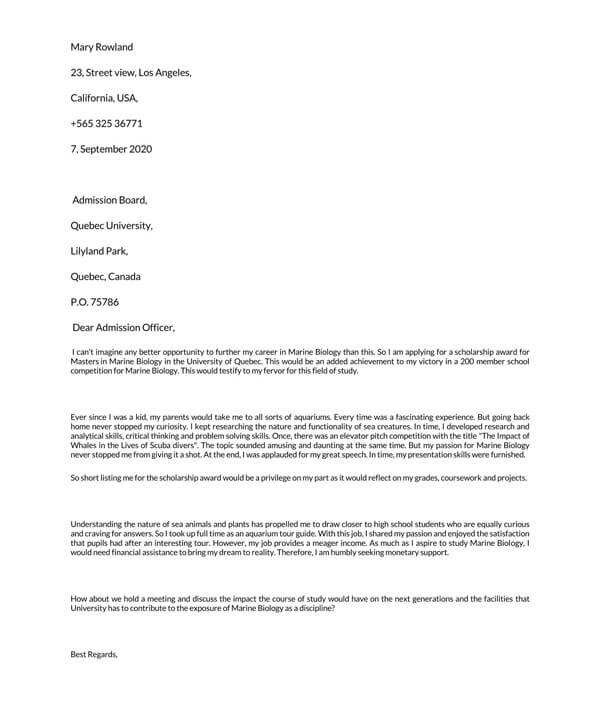

What do Scholarship Committees Require from Applicants?
Generally, scholarship committees look for some or all the following qualities in an ideal applicant.
- Candidate’s motivation and seriousness in the chosen field of study
- A detailed description of the specific course work or area of study
- The creativity and originality of the letter
- Leadership skills of the candidate as well as their emotional stability
- An applicant’s ability to collaborate with others and the desire to excel.
Tips for a Strong Application Letter
Here are a few tips to help you write a strong scholarship application letter:
- Explain why you are the perfect candidate for the scholarship: remember that you are trying to convince the scholarship committee that you are the perfect candidate for the scholarship. Convince them why they should choose you.
- Use a formal tone when writing and ensure that your letter has a clear structure and is free of any grammatical errors
- Write a great cover letter to go with your application letter: After drafting your application letter, write a great cover letter to act as an introduction and an invitation to review your application.
Many students fall under the category of those who are eligible for a scholarship. They may have excellent academic transcripts, or a list of extracurricular activities to boast about or a list of talents and hobbies. Whether you have those things or not, scholarship committees look for something else. That is students who have overcome challenges and major struggles, students who are leaders in their community, and those who have hobbies. It is a great idea to submit a scholarship application letter as it is your opportunity to think about how you can make yourself stand out from the other applicants and be selected for that scholarship sponsorship.
Related Documents
How to Write a Cover Letter for Scholarship
Learn how to showcase your skills and personality in your scholarship cover letter and increase your chance of becoming a top applicant by reading our guide!

Article highlights
A scholarship cover letter is a crucial part of most scholarship applications. A well-written cover letter can have a significant impact in the decision-making process as it is your chance to showcase your unique experience and personality. In this article, we'll go over everything you need to know to write a great scholarship cover letter.
What is a scholarship cover letter?
A scholarship cover letter, also called a letter of motivation, is a letter you write to the scholarship committee to request their consideration for a grant and persuade them that you are a deserving candidate for the scholarship. The main intention is to highlight your academic accomplishments and academic record .
In this letter, you should showcase your strengths and skills in a way that explains why you are a great candidate for the scholarship. Also, this is your chance to provide a more detailed overview of your academic and extracurricular achievements and interests that may not be covered in a CV or resume .
3 reasons to write a scholarship cover letter
1. it can help make your application stand out.
Academic scholarships are extremely competitive so you need to make sure you do everything in your power to be considered. Here's where a scholarship cover letter steps in. Scholarship committees receive numerous applications from students with straight A's, extensive lists of extracurriculars, and high exam grades. Use your cover letter to stand out and explain why you should win the grant .
2. It allows you to communicate your future plans
For institutions and foundations, a scholarship is an investment, thus naturally they want to be confident that it will pay off. That's why outlining how a particular grant aligns with your future research or work plans can make you a top applicant.
3. It can demonstrate your level of English
The majority of scholarships for international students expect the applicants to have high English proficiency . Most of the time, they require you to attach a certificate to your application. But even then, seeing your level of language skills in a scholarship cover letter can win you some additional points. However, it's important not to go overboard - remember this isn't an artistic essay.
Different forms of scholarship cover letters

Apart from the standard scholarship cover letter, particular scholarships may require you to submit information about yourself in a different form. It can be:
- a personal statement , which is meant to tell who you are as a person, your interests and motivations;
- a motivation letter , which communicates why you chose a particular program or scholarship, as well as how you fulfill the requirements;
- an essay , which typically answers one specific question about you;
- a form or a document with a few questions , where you'll have to answer specific questions (which may or may not cover the information you'd usually provide in a cover letter).
How to write a cover letter for scholarship: step-by-step guide
The main purpose of a scholarship cover letter is to showcase your strengths and goals and why those make you a great match for the grant. Here's a step-by-step guide to help you write a cover letter for scholarship:
Review the scholarship’s application requirements
Before writing your cover letter for a scholarship, always check the application requirements . Every scholarship can have different expectations, some applications even have specific questions they want you to answer, so make sure to do thorough research to tailor your cover letter to a specific grant .
This can give you a better idea of what to include in your application and highlight the experiences and skills that are not included in your resume but may increase your chances of being the winner.
Write an introduction
The introduction is where you can make a positive first impression on the scholarship committee and let them get to know you. In the introductory paragraph, you should cover:
- who you are,
- how you learned about the scholarship,
- why it sparked your interest.
Avoid using generic phrases and templates, and adjust your introduction to better fit the specific scholarship you are applying for.
Highlight your professional experience and internships
In the first body paragraph, you should highlight relevant skills and achievements and your professional experience and internships . Depending on the scholarship requirements, choose suitable experiences from your previous education and explain how they allowed you to gain knowledge and skills related to a particular field. This can demonstrate your learning style and commitment to personal growth.
Share your academic ambitions and interests
Describe your academic interests and ambitions in the next body paragraph. Generally, scholarships search for potential and want to help promising students to pursue their interest in academia. So keep in mind that scholarship committees may look for candidates with academic aspirations and ambitions .
Talk about your aspirations post-graduation
It is also important to talk about your post-graduation aspirations and long-term goals. Whether you want to continue your education or enter the industry, show the reviewing committee how this scholarship is a good investment in your future. Highlight how this funding could impact your career post-graduation.
Summarize your goals and credentials with a conclusion
Restate your interest in the scholarship and why you are a great candidate in the last paragraph of your scholarship cover letter. You can include your contact information and encourage the reviewing committee to reach out to you. This is also a good place to express gratitude for considering your application.
Proof-read and update your cover letter
Always check for spelling, grammar, and punctuation mistakes at least twice as they can point to a lack of attention to detail. Consider asking someone else , ideally, a professor, to review it and provide their insights and feedback . This way you can avoid missing any errors and adjust your tone and writing style .
Tips for writing a scholarship cover letter
Here are some other important things you should keep in mind while writing a scholarship cover letter:
Make your cover letter unique and personal to your interests and achievements
The reviewing committee has gone through many cover letters, having seen those generic templates and patterns numerous times. This is a chance for you to make your cover letter personal and unique . Describe your specific goals, showcase your personality, and provide all relevant information that can help you stand out.
Format your letter in a professional manner and check for errors
Match your letter to the recommended formatting to make it look more professional:
- use a simple font and an appropriate size
- check the margins on the sides of the pages
- check the spacing between the lines
- try to make it one page long (unless a different length is specified)
Always double- or triple-check for spelling mistakes . According to Forbes , typos and grammar mistakes are among the top 5 reasons why many students have their applications rejected.
Include quantifiable accomplishments
Choose quantifiable achievements that reflect the criteria related to applicants' skills and accomplishments. It helps the reviewing committee determine how you compare to other candidates . Consider including your grade average, your most notable project, and numerical data that demonstrates your performance in relevant academic and extracurricular activities.
Don’t forget to provide evidence to back up your points
It is helpful to refer to evidence to support your points. For example, you may consider mentioning the specific source of your skills or situations where you have successfully applied them. It's best to avoid including any information that cannot be backed up .
Here's a piece of advice from Swedish Institute Scholarship recipient Suci Ariyanti :
Be honest. Never give false information, or exaggerate things. Not only will the SISGP committee do random checks on applicants, but it is also important to keep your integrity intact.
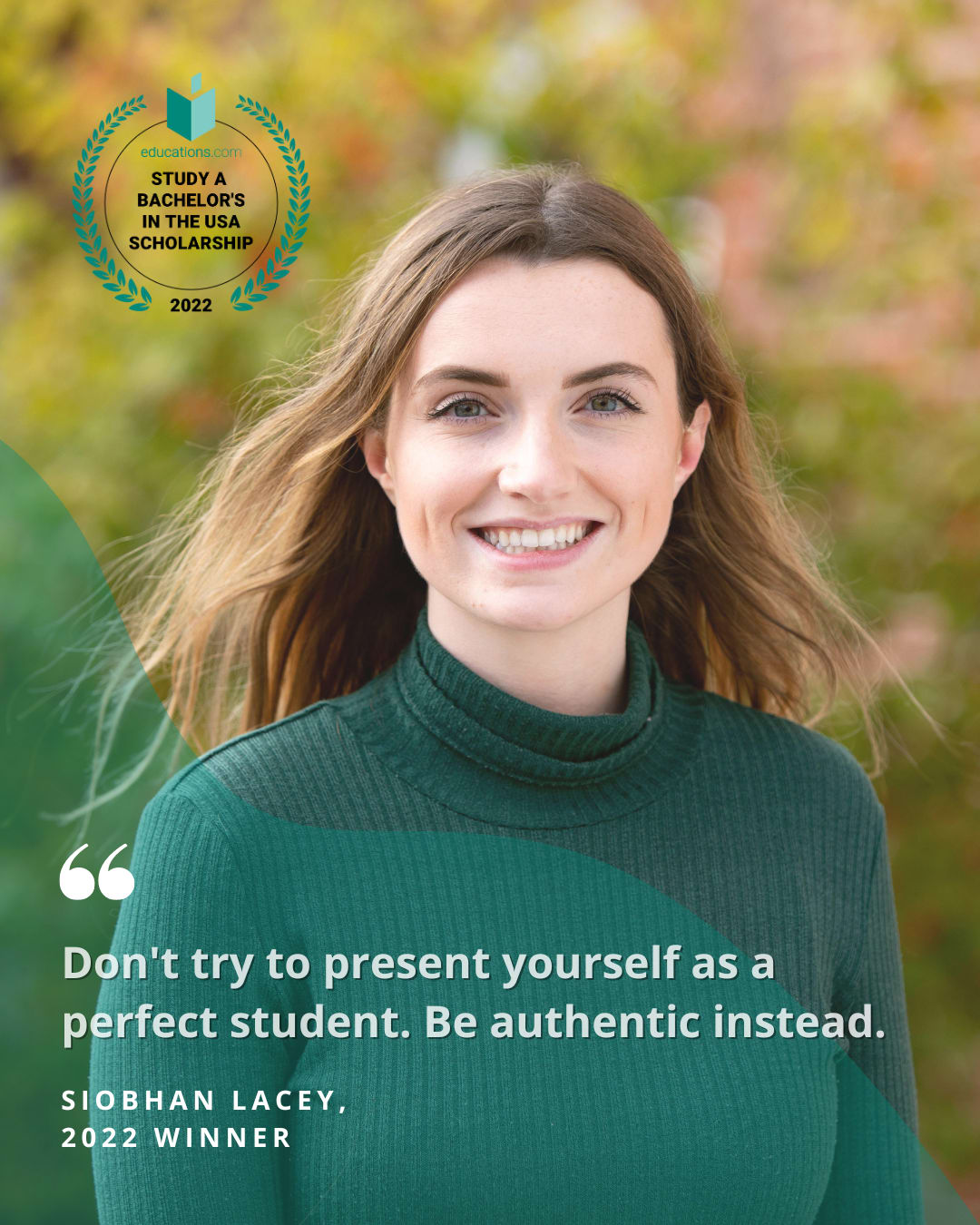
New scholarships from Educations.com
Women scholarship for international students 2024.
Application deadline: 25 August 2024 at 12:00 CEST

This $5,000 Women scholarship for international students will be awarded to globally-minded female students beginning their undergraduate, graduate, or post-graduate studies in the Fall 2024 semester or after. The award is meant to help cover your tuition fees and share your unique story as a woman with the world!
Undergraduate in STEM Scholarship 2024
Application deadline: 13 October 2024 at 12:00 CEST

Our STEM degree scholarship will be awarded to students starting their STEM studies in the Fall 2024 semester or later and is worth up to $5,000 . Students from all countries who will be studying for an undergraduate STEM degree abroad at a college or university can apply for this scholarship. We believe that students who study abroad become the next generation of globally-minded adventurers – so we want to help more of you reach your potential.
Graduate Study in the USA Scholarship 2024
Application deadline: 22 September 2024 at 12:00 CEST

Graduate Study in the USA scholarship is our first ever Master's degree scholarship . Students beginning their studies in the Fall 2024 semester or later can be awarded up to $5,000. It's open to international students from any country outside the USA who will be pursuing a Master's degree abroad at a college or university in the USA. It can be used to help cover tuition fees and get you one step closer to your next great adventure, in the USA.
More scholarships:
- Study a Master's in Europe Scholarship 2024
- Go Global MBA Scholarship 2024
- Study Abroad Scholarship Directory 2024
A scholarship cover letter gives you an opportunity to highlight your academic accomplishments and academic record and persuade the reviewing committee that you are a great candidate for the scholarship. Providing more information about you lets them get to know your personality and adds details to your application.
Make sure to spend enough time on this cover letter since it's a very important evaluation point during the decision-making process. Thoroughly research the requirements and tailor your letter to a specific scholarship . And don't forget that transparency is key , the selection committee aims to choose you for who you truly are!

Keystone Team Author
The Keystone Team is comprised of experienced educators and advisors dedicated to providing valuable resources and advice to students all over the world.
- Applying For Scholarships
Write a Killer Cover Letter for a Scholarship in 2023 (w/Example)
David Jul 24, 2022

Get our best scholarship practices, insights & tips delivered to your inbox
Thank you for subscribing!
It’s easy to get put off by scholarship applications that require a cover letter. Cover letters may seem annoying but there is a bright side here. A simple letter gives you another opportunity to convince the scholarship committee that you deserve to win the award.
So how do you start? What should you include in the letter? How should you end it? In this post, we’ll answer all these questions and we’ll even provide a sample letter that you can use as a template in the end.
What Is a Cover Letter?
Let’s start with the basics. A cover letter for a scholarship is similar to a cover letter you’d submit for a job . What does that mean exactly?
It’s simply a letter you write to the scholarship committee. In the letter you should explain what makes you a great candidate for the award. You should also talk about how the scholarship will help you reach your educational and career goals .
The fastest path to earning scholarships
Simplify and focus your application process with the one-stop platform for vetted scholarships.
The scholarship committee wants to find the most fitting students to invest their money in. Make them see the reasons why they should they invest in you.
Why a Cover Letter?

Whether you have those things or not, many scholarship committees look for something else. They look at students who have overcome struggles. Students who are leaders in their community. And students who have unique hobbies. Your cover letter is the place to show off your unique self.
Although not every scholarship application requires students to submit a cover letter, when they do, it’s a great idea to submit a great one. Use the opportunity to think about how can you make yourself stand out from other applicants. What is unique to you that other applicants don’t have? Brainstorm and show it off!
What Should Your Cover Letter Accomplish?
Your cover letter should do the following:
- Highlight your strengths: Why do your strengths make you a good match for the scholarship?
- Express what your plans are for the future: How will this particular scholarship help get you there?
- Convey a clear structure: Your cover letter should flow in a clear and concise manner.

Cover letters can be a great opportunity for you to convince the scholarship committee that you are the best candidate for the scholarship. Take time writing your cover letter and don’t wait until the final days before the deadline to start writing. A little bit of effort, could be the difference that helps you win the award!
Scholarship Cover Letter Example
Alexis Smith 4519 Owl St. Bend, OH 45052
The Scholarship Committee University of Pennsylvania 3440 Market Street Philadelphia, PA 19104
To Whom It May Concern,
My name is Alex Smith and I am a high school senior in Bend, Ohio. In the fall of 2019, I will be starting my freshman year at the University of Pennsylvania at the Annenberg School of Communication with an intended major in communications.
Since my freshman year of high school, I have served on my school’s journalism team. During freshman and sophomore year, I worked as a writer. By junior and senior year, I became the senior editor and co-manager of the school paper. Throughout my four years of being part of the club, I have learned so much about journalism; from pitching creative ideas, to carrying out interviews, and writing up an article. I have also learned about editing and publishing. Although these tasks intimidated me in the beginning, I can confidently say that I now feel very skilled and knowledgeable about the field.
I am particularly passionate about giving the underserved population a voice to be heard. Some of my favorite interviews and articles I have published have been with female refugees from the community here in Ohio. Some of my articles have been published in our local paper in Bend.
Of course, there is so much that I still have and want to learn. I am eager to start my undergraduate education and learn from experts in the field. I am excited to take journalism, communication, and marketing courses and learn everything there is to know. I am also hoping to work with the Pennsylvania Daily and join the journalism club on campus. I want to take advantage of every opportunity offered to further my career and personal growth.
As you are well aware, the cost of college is very high. As much as I have saved during high school, I will still have to take out loans to fund my college education. I am planning to work part-time during my studies, but I don’t want work to interfere too much with my school work. This scholarship would greatly help me cover some of these fees and give me more time to focus on school.
I am very hardworking and creative, and I can’t wait to contribute my talents to the University of Pennsylvania. I would be so grateful to receive a scholarship. Thank you for your time and I look forward to hearing from you soon.
Sincerely,
Alexis Smith
- Applications

David Tabachnikov is the CEO of ScholarshipOwl. Formerly at Waze and Google, David is an experienced CTO/R&D manager with over 10 years of experience of leading tech teams. David fervently believes that students should have greater access to education, and is passionate about using technology to help them achieve that goal.
Related Stories View All

Weird and Wacky Scholarships That Actually Exist

Are Pell Grants Taxable?

Tennessee Lottery Scholarship Program (TELS)
Get started with scholarshipowl.
Simplify and focus your application process with the one-stop platform for vetted scholarships
Application Letter for Scholarship Request Sample: Free & Effective
In this article, I’ll guide you step-by-step through the process of writing a compelling scholarship application letter, drawing on my personal experiences and providing a customizable template to get you started.
Key Takeaways
- Understand the Purpose: Learn why a well-crafted application letter is crucial for your scholarship success.
- Personalize Your Letter: Discover how to tailor your letter to reflect your unique experiences and the scholarship criteria.
- Structure is Key: Follow a clear and effective structure to ensure your letter is engaging and easy to read.
- Highlight Your Achievements: Tips on showcasing your accomplishments without sounding boastful.
- Proofread and Refine: Understand the importance of revising your letter to eliminate errors and improve clarity.
Step-by-Step Guide to Writing Your Scholarship Application Letter
Step 1: research and understand the scholarship criteria.
Before you start writing, it’s imperative to thoroughly understand the scholarship’s requirements and objectives. Tailor your letter to align with the values and goals of the scholarship provider.
Step 2: Start with a Strong Introduction
Begin with a compelling introduction that captures the reader’s attention. Introduce yourself, mention the scholarship you’re applying for, and express your enthusiasm and commitment to your educational goals.
Step 3: Highlight Your Achievements and Qualifications
Detail your academic achievements, extracurricular activities, and any relevant experiences that demonstrate your suitability for the scholarship. Be specific and use examples to illustrate your points.
Step 4: Explain Why You Deserve the Scholarship
Articulate why you’re a deserving candidate for the scholarship. Link your personal, academic, and career goals with the scholarship’s objectives. Show how the scholarship will help you achieve your aspirations.
Step 5: Conclude with a Strong Closing Statement
End your letter on a confident note. Reiterate your gratitude for the opportunity and express your eagerness to contribute positively if granted the scholarship.
Step 6: Proofread and Edit Your Letter
Ensure your letter is free from grammatical errors and typos. A well-polished letter reflects your attention to detail and seriousness about the scholarship.
Personal Tips from Experience
- Be Authentic: Authenticity resonates. Share genuine stories and experiences that reflect your true self.
- Stay Positive: Even when discussing challenges, focus on how you’ve overcome them or what you’ve learned.
- Be Concise: Respect the reader’s time. Keep your letter clear and to the point without sacrificing important details.
- Seek Feedback: Don’t hesitate to ask a mentor or a peer to review your letter. Fresh eyes can catch errors and offer valuable insights.
Application Letter Template for a Scholarship Request
[Your Name] [Your Address] [City, State, Zip] [Date]
[Recipient’s Name] [Recipient’s Title] [Scholarship Committee’s Name] [Address] [City, State, Zip]
Dear [Recipient’s Name],
I am writing to express my earnest interest in the [Scholarship Name] offered by [Institution or Foundation’s Name]. As a dedicated student of [Your Field of Study], I am committed to my academic pursuits and am eager to overcome financial barriers to achieve my educational goals.
Throughout my academic journey, I have maintained a [Your GPA] GPA and have been actively involved in [List any relevant extracurricular activities or community service]. These experiences have not only enriched my knowledge but have also honed my skills in [Mention key skills relevant to your field or scholarship].
The [Scholarship Name] resonates with my personal and academic aspirations by [Explain how the scholarship aligns with your goals]. Your support would immensely help me [Briefly mention how the scholarship will aid your education and future plans].
Thank you for considering my application. I am enthusiastic about the opportunity to contribute to [Mention any relevant community/service goals aligned with the scholarship] and am committed to making the most out of the scholarship if granted the opportunity.
Sincerely, [Your Name]
Engage with Us
I hope this guide empowers you to craft a persuasive application letter that brings you one step closer to your academic and career goals. If you’ve found these insights helpful or have your own experiences to share, please leave a comment below.
We’d love to hear about your journey and any additional tips you might have for aspiring scholarship applicants!
Frequently Asked Questions (FAQs)

Q: How Should I Start My Application Letter for a Scholarship Request?
Answer: When starting your application letter for a scholarship, it’s crucial to grab the reader’s attention immediately. I began mine with a strong opening sentence that highlighted my enthusiasm and passion for the field I am pursuing.
For example, “As a dedicated and innovative student in environmental science, I am excited to apply for the XYZ Scholarship to further my goal of developing sustainable energy solutions.”
Q: What Personal Achievements Should I Include in My Scholarship Application Letter?
Answer: In your scholarship application letter, focus on achievements that are most relevant to the scholarship. In mine, I included my academic accomplishments, like being at the top of my class in relevant subjects, and extracurricular activities like leading a community clean-up project.
It’s not just about listing achievements; it’s about demonstrating how these experiences have prepared you for the scholarship.
Q: How Can I Show My Need for the Scholarship in the Application Letter?
Answer: Demonstrating your need for a scholarship can be done tactfully by sharing personal stories or challenges that have shaped your educational journey.
In my letter, I discussed how financial constraints have been a significant hurdle in my academic pursuits, and how the scholarship would alleviate these burdens and enable me to focus more on my studies.
Q: Should I Mention My Career Goals in the Scholarship Application Letter?
Answer: Absolutely! Discussing your career goals is vital. In my application letter, I clearly outlined how the scholarship would help me achieve my long-term career goal of becoming a renewable energy consultant. I explained how the specific courses and opportunities provided by the scholarship are aligned with my career aspirations.
Q: How Do I Conclude My Scholarship Application Letter?
Answer: The conclusion of your scholarship application letter should be compelling and memorable. I concluded mine by reiterating my passion and the alignment of my goals with the scholarship’s purpose.
I also thanked the committee for considering my application and expressed eagerness about the possibility of contributing to the field with their support.
Related Articles
Acing the “strengths and weaknesses” question in a scholarship interview, cover letter for student finance sample: free & customizable, email for scholarship application: how to write it right, 3 proven scholarship letters: secure your funding, 1 thought on “application letter for scholarship request sample: free & effective”.
This is Awesome and helpful..😉
Leave a Comment Cancel Reply
Your email address will not be published. Required fields are marked *
- Success Stories
- AI Scholar Program
- Startup Internship Program
- Research Scholar Program
- GOALS Academic Support Program
- Test Prep Program
- Passion Project Program
- For Families
- For Schools
- For Employers
- Partnerships
- Content Guides
- News And Awards
- College Admissions
- Events and Webinars
- Applications
- Pre-Application
How to Create a Student Cover Letter for Scholarships
Julia de Raadt
Head of research and lead admissions expert, table of contents, tips to create cover letter for scholarships, know your strengths with empowerly.
Stay up-to-date on the latest research and college admissions trends with our blog team.

Many students with good grades, high SAT scores, and an extensive list of extracurriculars apply for scholarships every year. However, in order to stand out from the rest of your competition, you need a resume with a strong cover letter for scholarships.
To write a student cover letter, you may need the help of a professor, family, or guidance counselor . This will ensure that your cover letter for a scholarship highlights not only your academic achievements but also your strongest skills and talents. It’s critical that you put your best foot forward.
So, how do you create an impressive cover letter for a scholarship? Well, let us dive right in.
In order for your scholarship application to stand out from the rest, you need to tell a compelling story to the scholarship committee. Therefore, you must use every word carefully when explaining your motivations, accomplishments, and challenges in life.
No matter what type of scholarship you apply for, all cover letter examples for students follow a standard format. So, follow the following steps to write the best cover letter for a scholarship you can.
Tip #1 – Adhere to the Structure
It can be a real challenge to sell yourself to the scholarship committee. Therefore, if you are struggling to start or write a cover letter for a scholarship, knowing the overall outline can help. The structure or format of a student cover letter consists of six main components, which are:
- Personal information – contains your full name, address (if you choose to share), and other contact information, including email address and phone number
- Salutation – always start by addressing “Scholarship Committee” or “Dear Sir/Madam” if you know the name of the specific person responsible for making a decision.
- Opening paragraph – this section must include a summary of your career goals and plans.
- Body – the body must provide details about your educational background, work experience, previous awards and honors, volunteer experience, etc. This section can be two to three paragraphs: one about your academics, and one about your work experience/skills/volunteering experience. The last paragraph must curtail how a scholarship is going to help you achieve your career goals.
- Closing with a call to action – thank the scholarship committee for considering your application, followed by a call to action such as “if you need further information, please feel free to contact me,” etc.
- Sign-off – end the closing letter with “sincerely,” “kind regards,” or “best regards.”
Tip #2 – Be Concise
The idea of a cover letter for scholarships is to give committees an overview of your entire academic journey, motivations, and life from your point of view. However, it does not mean that you have to tell your entire life story—and you’ll definitely want to avoid restating the information that you’ve already written in your resume itself. Keep your cover letter concise by only highlighting a couple of relevant events to your college admission, career goals, and scholarship, and focus on communicating your personal voice.
Therefore, your cover letter for a scholarship must include the following information.
- You must start by giving an overview of your academic self and what your strengths are
- You must demonstrate your academic history and help the scholarship committee see why they should award you the scholarship
- Do not forget to convey your future goals while sounding enthusiastic about the scholarship
- State how you plan to use your scholarship
If you are unsure how to showcase your skills or what your strengths are, take the Empowerly Quiz . This small quiz will evaluate your academic background, work, and volunteer experiences to give you a score. If you sign up to receive your Empowerly Score, your test results will also highlight the strengths that you can use on your resume and cover letter for scholarships.
Tip #3 – Customizing your Cover Letter for Scholarships
As you write a student cover letter, it is the little touch of personalization that will make it unique. Just imagine scholarship committee members coming across a cover letter amongst the pile and finding one that is thoughtful and personalized rather than sounding generic.
The best way to customize your cover letter for a scholarship is to write an introductory paragraph that includes information relevant to that scholarship in particular. Tailoring your cover letter’s body will give your application a better chance of approval as well.
However, the criteria to grant scholarships vary widely. Partnering with Empowerly can help you gain access to guidance, career counseling, and expert advice that will help you make the most of your cover letters and resumes.
Applying for a scholarship is a big challenge. However, having a professional guide or counselor on your side can help you improve your chances of approval. Why not consult with Empowerly ?
Register as an Empowerly student and learn about your best skills and strong suits that you can highlight in your cover letter for scholarships. The Empowerly Score is only available to students in the Empowerly Portal — it’s a separate form and result process that gives you a detailed report. Speak to us to learn more about these resources today!
Share this article:
College apps can be overwhelming, but you don’t have to do it alone. empowerly college counseling is in it with you., related articles.

Student Voice: The Raw, Unfiltered Value of College Counseling
Empowerly Students Receive Early Admissions for University of California Class

Dealing with Application Stress
How To Write a Scholarship Application Letter That Stands Out
.jpg)
If you’re planning to attend college, securing financial aid can be a crucial step in achieving your academic and career goals. Scholarships provide an excellent way to ease the financial burden of pursuing a degree, and there are so many options available, especially for Christian colleges!
To access these opportunities, you'll often need to submit a scholarship application letter, which may seem challenging to navigate if you’ve never written one before. But don’t worry! In this guide, we'll explore the essential components of a scholarship application letter, how to write one, and how to find scholarship opportunities tailored to your aspirations.
What is a Scholarship Application Letter?
A scholarship application letter is a formal document that introduces you to the scholarship review committee. It serves as your chance to present yourself as the ideal candidate for the scholarship and gives more details about who you are beyond your personal information.
This letter, often accompanied by a scholarship essay, provides valuable insights into your academic achievements, career goals, and the reasons you deserve financial aid. A well-written scholarship application letter can significantly influence the committee's decision and increase your chances of earning the award.
When writing a scholarship cover letter, remember that it's more than just a summary of your achievements. It's an opportunity to convey your passion, dedication, and the unique qualities that set you apart from other applicants. Make a strong impression by showcasing your enthusiasm for your chosen field of study, the university, and the impact you hope to make.

How Can I Find College Scholarships?
With so many options available, navigating the world of scholarships requires a strategic approach. Start by exploring opportunities available through your high school and prospective colleges. Many institutions offer financial aid programs as part of their application process. You can organize a meeting with the college counselor at your school, explain your situation and interests, and provide them with a list of schools you’re interested in.
Additionally, online scholarship databases are another excellent way to seek them. Use websites that allow you to search for scholarships based on factors like education and career interests, academic and professional careers, and even personal characteristics. Narrow down your options to those that resonate with your career goals.
When searching for scholarships, you should consider both local and national opportunities. Don't overlook the possibility of scholarships from local businesses, community organizations, foundations, or clubs that want to support students in your area. As a student seeking a Christian college, you may even find support from a local church. Cast a wide net while remaining focused on scholarships that align with your field of study and aspirations.
Also, be sure to keep an eye out for scholarship scams ; unfortunately, some people take advantage of vulnerable students and solicit personal information, money, and other sensitive data. A reputable scholarship source will never ask you to submit sensitive personal information like a credit card or bank account number to apply.
How Do I Write a Good Scholarship Application Letter?
Now, the part you’ve been waiting for! Here are our tips for writing the best scholarship application letter and improving your chances of success. Crafting a compelling letter requires attention to detail and a clear understanding of what the committee is looking for.
- Research the Scholarship:
Understand the scholarship’s mission and values. Tailor your letter to align with their objectives.
- Address the Letter:
Use a formal salutation addressing the scholarship review committee.
- Introduction:
Begin with a strong opening that introduces you, your academic journey, and your ambitions. Try to use an engaging hook that will catch the reader’s attention.
- Highlight Achievements:
Showcase your academic accomplishments, extracurricular activities, and any notable achievements. You don’t need to rattle off everything; focus on the major successes that you’d like to highlight.
- Connect to Career Goals:
Link your achievements to your career goals. Explain how the scholarship will help you advance in your chosen field and give examples of the impact you’d like to make.
- Financial Need:
If applicable, discuss your financial need and how the scholarship will assist you in achieving your education and career aspirations.
- Unique Traits:
Emphasize what sets you apart from other applicants. Highlight experiences that demonstrate your dedication and commitment.
- Conclude Strongly:
Summarize your key points and express gratitude for the opportunity to apply.
- Polish and Proofread:
Ensure your letter is well-structured, free of errors, and aligned with the scholarship’s requirements. You can ask friends and family, professors, and college counselors at your school to read it before you submit your application.

Remember, a scholarship cover letter reflects your dedication and aspirations. It’s your chance to make a lasting impression on the committee. Stand out by researching the university or organization you're applying to and emphasizing your unique qualities.
Also, don’t get discouraged if you don’t get a scholarship you applied for. It may be hard, but there are so many opportunities out there; you’re sure to find something that will fit your needs. Your counselors and resources like Find Your Christian College are always here to help!

How To Write Scholarship Application Letter (FREE Sample Templates)
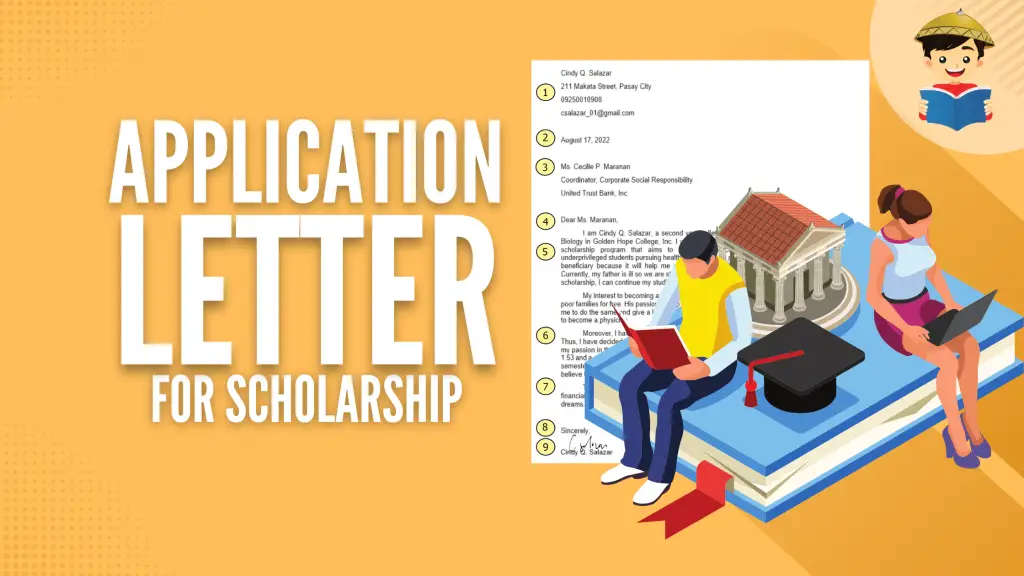
With limited slots and hundreds of aspiring applicants, grabbing a scholarship opportunity feels far from someone’s reach.
Through a scholarship application letter, you can increase your odds of getting the grant by standing out from other applicants.
Let this article guide you on how to write an impressive scholarship application letter.
Table of Contents
1. university-based scholarship application letter (for college students), 2. school-based scholarship application letter (for high school students), 3. government scholarship application letter, 4. private scholarship application letter, 5. scholarship application letter addressed to a public official (i.e., mayor, governor, congressman, etc.), 6. post-graduate scholarship application letter.
- 7. Foreign Scholarship Application Letter
What Is a Scholarship Application Letter?
What is the difference between a scholarship application letter and a letter of intent (loi) for a scholarship, what is the difference between a scholarship application letter and a scholarship essay, what does a scholarship application letter look like, 1. get to know the scholarship you’re applying for, 2. complete the letterhead and provide a short salutation, 3. introduce yourself and mention your desire and reason for applying, 4. convince the scholarship committee you deserve to get the scholarship using your academic achievements, extra-curricular activities, soft skills, etc., 5. highlight the significance of scholarship to your success and express your gratitude to the reader, 6. conclude your letter, tips and warnings, at a glance: scholarship application letter templates (free download).
Do you need to make a Scholarship Application Letter in haste? We’ve got you covered!
Select from the list of free downloadable and editable scholarship application letter templates below. Just click the corresponding link of your preferred template to automatically download the Microsoft Word file.
7. Foreign Scholarship Application Letter

A scholarship application letter is a formal document that convinces the recipient that the sender is the best pick for the scholarship. It highlights the applicant’s qualifications, achievements, and experiences to ace the grant.
The application letter also states your reasons for applying for the scholarship, as well as an explanation of how the grant will help in your studies.
To add a “personal touch” to this letter, you may use personal anecdotes and testimonials. However, the letter’s tone should be formal rather than casual because it is an academic/professional document.
Although both documents increase your chances of getting the grant, they convey different messages.
A scholarship application letter convinces the reader that you’re an exceptional candidate for the scholarship grant. Specifically, it highlights the most compelling reasons why you deserve the scholarship. You can focus on your academic achievements, socioeconomic condition, or personal attributes.
This letter may include personal anecdotes, testimonials, and other supporting information that will help with your application. You may even state who your role model is and how they influence your passion to achieve your dreams.
Meanwhile, the main focus of an LOI is to express your interest in applying for a scholarship. Your qualifications, experiences, and socioeconomic conditions are stated briefly as supporting details. For this reason, an LOI is usually shorter, more straightforward, and has less room for personal anecdotes.
There are also some differences between their structure. The upper part of a scholarship application letter indicates your details (name, address, contact details). In an LOI, this part is usually located at the bottom.
A scholarship essay usually asks a particular question like, “Why do you deserve the scholarship?” , “How can our scholarship help you?” or “Who is your biggest inspiration?” It’s important in a scholarship essay that your answer is well-thought-out, clear, and creative.
Meanwhile, a scholarship application letter is more of an extension of your documentary requirements. It expounds the details indicated to highlight your best attributes so that the scholarship committee will pick you. The topic of the letter is “you,” and there’s no question you’re supposed to answer.
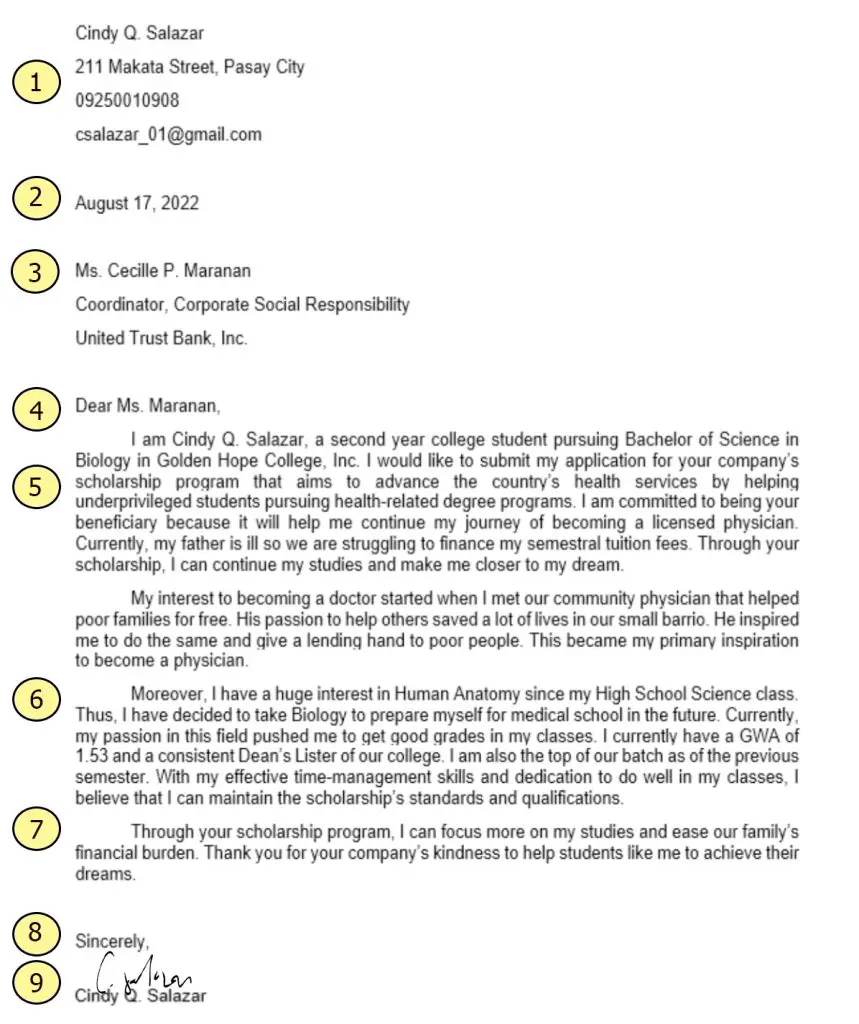
1. Personal Information : Located at the top of the letter, this section is where you indicate your full name, address, and contact details.
2. Date: The date when the letter is submitted
3. Recipient: This is where you indicate the name, position, and institution/company of the letter’s recipient
4. Salutation: If the recipient’s name is unspecified, you may use the line “To whom it may concern”
5. Introduction: This part includes your name and current educational attainment, as well as a brief statement of your desire to apply for a scholarship and the reason/s behind it
6. Body of the letter: This part highlights everything that makes you deserving of a scholarship (e.g., personal attributes, academic achievements, extra-curricular activities, etc.). It may also include personal anecdotes and testimonials.
7. Conclusion: This section is where you express your gratitude to the recipient and emphasize how the grant will help you in your studies.
8. Closing Remark: A short formal closing statement (e.g., Regards, Sincerely, etc.)
9. Signature
How To Write a Scholarship Application Letter
There are two reasons why you need to do this before drafting your letter.
First, to avoid stating wrong information in the letter.
Second, to help you decide what your “focus” is so that the letter will suit the scholarship requirements. Suppose the grant requires the applicant to have exceptional leadership skills. To meet this qualification, you need to brush up on your memory for any leadership roles you had in the school and include them in your letter.
Your letterhead should contain three sections: your details (name, address, and contact info), the date when the letter is submitted, and your recipient’s details.
Afterward, provide a short salutation like “Dear <insert name>” and “Greetings <insert name> .
Performing this step completes your letter’s introduction. In case you’ve recently graduated, mention your alma mater.
Don’t forget to mention in this portion your understanding of the scholarship’s goal and how it is aligned with your aspirations and current circumstance.
In the example above, the sender wrote that the scholarship aims to help underprivileged students pursuing health-related courses. Thus, she wrote that her dream of becoming a physician led her to major in Biology.
Finally, state your reason for applying for a scholarship.
Your goal in this step is to complete your letter’s body. State here your best attributes that make you stand out from other applicants. It depends on you how many paragraphs you’ll write for this section.
Here is some information you can include in your letter’s body:
- Academic achievements (e.g., consistent Dean’s lister, class valedictorian/salutatorian, academic honors like Best in Math or Best Research Paper, or high GWA , etc.)
- Extra-curricular experiences (e.g., leadership roles in the Student Council, student organizations, and NGOs, as well as awards received from competitions, etc.)
- Certifications (e.g., TESDA National Certificate)
- Work and internship experiences
- Personal attributes (e.g., interpersonal skills, time-management skills, perseverance, etc.)
- Other information that may suit the scholarship requirements. For example, if you’re applying for sports-related grants, you can mention the competitions you’ve won, your experiences as a student-athlete from another school, etc.
Only select attributes that are related to the scholarship’s requirements. For example, if they are looking for good academic standing, you must focus on featuring your grades and academic achievements. If the grant is looking for leadership skills, then highlight your leadership roles in student clubs or even in non-academic organizations.
You may also add personal anecdotes in this portion. For instance, the sender of the sample letter above shares her experience meeting a doctor who inspired him to pursue the same profession.
Briefly mention that the scholarship will help you accomplish your studies and ease your family’s financial burden. Afterward, thank the recipient for taking the time to read your letter.
Close your letter by adding a closing remark (e.g., Regards, Sincerely, etc.) and affixing your signature.
- Strictly follow the required word count, if there’s any. To save time reading tons of letters that scholarship committees receive, they set word count limits that applicants should follow. Hence, no need to make your application letter wordy; as long as it contains the most essential details, that would be enough. As the saying goes, “brevity is the soul of wit.”
- Be truthful. Do not include misleading information to stand out from the competition. Some scholarship committees conduct cross-checking to verify the information indicated in application letters. Get caught and lose your chance to enjoy the grant.
- Don’t be “too emotional.” It’s true that your letter becomes more convincing if you state your challenges and economic hardships. However, over-relying on “emotional appeal” might repulse your reader. Thus, avoid oversharing private matters in your letter. Moreover, refrain from adding “rant” statements (e.g., education is for the privileged only, tuition hikes are anti-poor, etc. ) in your letter. There’s a different avenue to express those frustrations.
Written by Jewel Kyle Fabula
in Career and Education , Juander How
Last Updated September 2, 2022 03:00 PM
Jewel Kyle Fabula
Jewel Kyle Fabula is a Bachelor of Science in Economics student at the University of the Philippines Diliman. His passion for learning mathematics developed as he competed in some mathematics competitions during his Junior High School years. He loves cats, playing video games, and listening to music.
Browse all articles written by Jewel Kyle Fabula
Copyright Notice
All materials contained on this site are protected by the Republic of the Philippines copyright law and may not be reproduced, distributed, transmitted, displayed, published, or broadcast without the prior written permission of filipiknow.net or in the case of third party materials, the owner of that content. You may not alter or remove any trademark, copyright, or other notice from copies of the content. Be warned that we have already reported and helped terminate several websites and YouTube channels for blatantly stealing our content. If you wish to use filipiknow.net content for commercial purposes, such as for content syndication, etc., please contact us at legal(at)filipiknow(dot)net

Graduate School Application Tips & Advice

Applying to graduate school can be both exciting and a little overwhelming. You’re making a decision that could advance your career or allow you to dive deeper into a subject area that fulfills your personal goals, but you’re also making a significant investment of your time and finances.
With proper research, a clear head, and confidence, however, you can find the perfect program and submit an application that the admissions committee will be hard-pressed to reject.
Are you thinking about applying to graduate school? Here’s what every prospective student needs to know.
Tips for Applying to Graduate School
1. find a program that aligns with your goals ..
Finding the right graduate program can sometimes feel like the hardest part of the process. It’s important to find the right program for you, and with different degrees and certificates popping up at universities across the country, there are likely dozens of options available to you.
Write down the most important features of your ideal program before you begin your research. For example, do you want a full-time, on-campus experience or a flexible, online environment? Do you want research-based coursework or a program with experiential opportunities integrated into the curriculum? Once you have your list of non-negotiable features, you can kick off your research.
Learn More: How to Organize Your Grad School Search
After you’ve explored a range of programs, consider your career goals and how each program can help you achieve them. If you’d like to hone your skills to work in a specific focus area of a broader field, for instance, a program that offers a concentration or certificate aligned with those skills can be beneficial. On the other hand, if you’d like to have flexibility in your chosen career, pursuing a broader degree program that can be applied across various functions may be better suited to your needs.
Investing in this research upfront will help you find a graduate program that is right for your specific goals and allow you to feel more confident in your choice when it comes time to complete and submit your application.
2. Ask questions .
The old-school idea that the admissions office is a scary room filled with judgment is a falsehood. Today, graduate school admissions counselors are here to help guide you through the application process process. They want to be there to support your educational journey. If you have any questions, ask . Don’t worry that your interactions with the admissions team could impact your application. If anything, your interactions will only help improve your application before review and help demonstrate your sincere interest in the program.
Many colleges and universities offer online resources where prospective students can find information about the application process and requirements. Getting in touch with an admissions counselor, though, may be the most efficient way to find answers to specific questions you might have. Engaging with them will also give you a chance to get to know the school better and decide if what they offer is really the right fit for your needs.
Consider This: Admissions counselors are well-versed in the logistics of application requirements, individual programs, and financial aid and scholarships . If you have specific questions, be sure to reach out to them for the clarity and insight you need at any step of the process.
Prospective students should not be afraid of contacting faculty, either. If there’s a particular class you’re interested in taking or a lab you hope to work in, contact the faculty member in charge. Ask about that faculty member’s research and pose any questions about the degree program that you might have. You may have a better chance of standing out during the admissions process if you express interest early.
Ready to Get Your Questions Answered?
Reach out to our admissions team for personalized advice on the application process.
GET IN TOUCH
3. Understand the timeline.
Although the application process varies by college or university, the vast majority will require you to submit your transcript, letters of recommendation, professional resumé , and statement of purpose. Your transcript alone could take weeks to be delivered and processed, so don’t wait until the last minute to start applying.
In an effort to avoid procrastination, consider developing a calendar of deadlines. Map out when you need to apply to each of your desired schools and the specific requirements for that program. For example, if you need to submit your undergraduate grades, create a to-do at least a month before the application deadline that reminds you to order your transcript.
4. Update your resumé.
Before sending your resumé, make sure it’s optimized for your grad school application . In general, your experience should be listed in chronological order, starting with your current position, and described in bullet points using action-packed verbs, such as “achieved,” “improved,” “launched,” “negotiated,” or “trained.” Quantify any achievements and show your results, whether it’s the number of people you’ve managed, dollars you’ve raised, or articles you’ve written.
To help your resumé align with your grad school application, be sure to tailor it to the program you intend to pursue by showcasing your skills, highlighting relevant experience, and including your professional achievements.
5. Write a strong statement of purpose.
While some might think that a statement of purpose —or personal statement —is an afterthought during your application review, many admissions committees, consider it one of the most important components of your application. The statement of purpose can make or break your application for admission.
The key to crafting an impactful statement of purpose is to not get caught up in what you think the admissions committee wants to hear. Use this opportunity to tell the committee more about who you are and your background while also explaining specifically what you hope to get out of the program. Be sure to address the unique features the school offers that interest you most.
For Example: If you plan to apply to Northeastern, you might consider highlighting experiential learning as the unique feature that interests you about your program. In this case, you might explain that you’re excited to tackle real-world projects in your desired industry and learn from faculty who are experts in your field of study.
No matter where you apply, a strong statement of purpose should include:
- Insight into what drives you, whether that’s professional advancement, personal growth, or both
- The features about the school that appeal to you most
- Your expectations of the degree program and its potential impact
- Authenticity and a clear picture of what makes you unique
6 . Choose appropriate references .
Letters of recommendation are another piece of the application process that helps elevate your application for admission. When it comes to asking for letters of recommendation , carefully consider whom you’re contacting. You want to choose someone who knows you well and can speak to your strengths.
Reach out to a professor you regularly interacted with who can detail your academic accomplishments and describe why you were a standout student. You can also ask a former supervisor who’s working in a field that aligns with the graduate program you’re pursuing. No matter your choice, make sure it’s someone you know in a professional or academic capacity—not a friend or family member—who will to provide a positive recommendation representative of your character.
You can typically provide either a professional or academic recommendation in support of your application, but programs have specific requirements around who is writing the recommendation and what the content needs to address. Research what each program requires before you coordinate your references.
When asking for a recommendation, provide your chosen reference with as much information about your request as possible. The more insight you can provide, the better your recommendation letter will be. Include in your first outreach:
- The name of the school you’re applying to
- The degree you’re pursuing
- Why you want to enroll in that specific program
- Your resumé
Make sure you keep your timeline in mind as you embark on these communications, especially if you reach out to a professor. It’s likely your letter isn’t the only one he or she needs to write, so be respectful of their time by giving as much notice as possible. Four weeks is ideal.
7. Proofread your materials before applying.
You could be a perfect fit for your desired program, but if you submit materials that are riddled with spelling and grammar errors, the admissions team might dismiss your application before ever digging into it. Triple-check your materials and make sure that when you do press send, you’ve included all necessary documentation and hit all deadlines set in place by the university.
It’s easy for an individual to unknowingly overlook their own mistakes, so it can also be helpful to ask a friend to review your materials before you submit them, as well. Reading your materials out loud to yourself can also help you spot potential mistakes.
Though this may seem like a lot of effort, remember: Your application is the first impression you will make on the university, and it’s important to put your best foot forward.
8. Be true to yourself .
Of all the tips for applying to graduate school, the most important is being true to yourself. Being perfect is not the recipe for admission; admissions committees want to know the real you and understand your ambitions. Whether you’re a working professional hoping graduate school can bring you to the next level of your career or a recent graduate looking to further master your chosen skill, just be yourself, and you’ll start off in the right direction.
Applying to Northeastern’s Graduate Programs
If you are interested in applying to one of Northeastern University’s 200+ online, on-ground, or hybrid graduate degree and certificate programs , there are various resources available to help you along the way.
First, it is important to understand the application process and requirements. Specific application requirements vary by college and degree, so be sure to explore the admissions information for your desired program before getting started. In general, however, the application requirements for Northeastern’s graduate programs include:
- A completed online application
- Transcripts from all undergraduate and graduate schools you’ve previously attended
- A statement of purpose that details your goals and interest in the program
- One to three letters of recommendation (varies by program)
- Your updated professional resumé or curriculum vitae
- Your official GRE, GMAT, or LSAT test scores (if required)
- A non-refundable application fee
Additionally, international students who are non-native English speakers must submit proof of English proficiency in the form of TOEFL, IELTS, PTE, or Duolingo test scores, though the minimum scores vary by program. Students who do not meet the minimum requirement for these scores may also apply to the university’s Global Pathways program .
As always, students who intend to apply to a graduate program at Northeastern should also research the application deadlines for their program of interest. Be sure to set a timeline for yourself and avoid procrastination to ensure that you’re able to submit all of the required materials on time.
The faculty and admissions team at Northeastern are always available to help prospective students throughout this journey, and prospective students are always encouraged to reach out to ask questions and get personalized advice . Whether you need information about selecting the right program, the application process, program-specific requirements, financial aid, or anything in between, the admissions team is here to help.
The First Step Toward Grad School Success
Once you’ve made the decision to further your education and pursue a graduate degree or certificate, submitting your application is the first step toward being a successful graduate student.
No matter where you choose to apply and ultimately attend, there are countless resources available to help you throughout the process.
To learn more about the specific schools and programs you are interested in, it’s always best to start by reaching out to admissions teams and faculty to get to know what makes them unique and ask any questions you might have. Building these relationships early on will help you find a program that fits your personal and professional goals, and can ultimately help you through the process of getting accepted to a program that’s right for you.
Are you interested in applying to graduate school? Explore Northeastern’s degree and certificate programs , and contact us for personalized advice.
This article was originally published in August 2017. It has since been updated for accuracy and relevance.
Subscribe below to receive future content from the Graduate Programs Blog.
About shayna joubert, related articles.

Why Earn a Professional Doctoral Degree?

5 Tips to Get the Most out of Grad School

Is Earning a Graduate Certificate Worth It?
Did you know.
Advanced degree holders earn a salary an average 25% higher than bachelor's degree holders. (Economic Policy Institute, 2021)
Northeastern University Graduate Programs
Explore our 200+ industry-aligned graduate degree and certificate programs.
Most Popular:
Tips for taking online classes: 8 strategies for success, public health careers: what can you do with an mph, 7 international business careers that are in high demand, edd vs. phd in education: what’s the difference, 7 must-have skills for data analysts, in-demand biotechnology careers shaping our future, the benefits of online learning: 8 advantages of online degrees, how to write a statement of purpose for graduate school, the best of our graduate blog—right to your inbox.
Stay up to date on our latest posts and university events. Plus receive relevant career tips and grad school advice.
By providing us with your email, you agree to the terms of our Privacy Policy and Terms of Service.
Keep Reading:

The 8 Highest-Paying Master’s Degrees in 2024

How To Get a Job in Emergency Management

Join Us at Northeastern’s Virtual Graduate Open House | March 5–7, 2024
$2,000 No Essay Scholarship
Help cover the cost of college without writing a single essay!
Niche is giving one student $2,000 to put toward tuition, housing, books or other college expenses — no essay required.
Apply below for your chance to win so you can focus on your education, not your finances. Good luck!
Min 7 characters
By proceeding you acknowledge and agree to our Privacy Policy and Terms of Use .
By proceeding you acknowledge and agree to our Privacy Policy and Terms of Use and Scholarship Rules .
Who Can Apply
All high school and college students, as well as anyone looking to attend college or graduate school in the next year. Please note: Not everyone is eligible for this scholarship. Niche sponsored scholarships and sweepstakes are for people with US citizenship or a valid Visa/US passport only. Read the scholarship rules for full eligibility requirements.
How It Works
The $2,000 “No Essay” Scholarship is an easy scholarship with no essay required! Only one entry allowed per person. The winner will be determined by random drawing and then contacted directly and announced in Niche's email newsletter and on the Scholarship Winners page.
About Niche scholarships
We believe cost shouldn’t keep anyone from pursuing a higher education, so we connect students with thousands of scholarships — many of which don’t require an essay — to help them afford college. In 2023 alone, we offered over $285,000 in Niche scholarships. Read more about Niche scholarships here or visit our FAQs .
This Was A Historic Admissions Cycle—Here Are All Of The Ivy League Acceptance Rates
- Share to Facebook
- Share to Twitter
- Share to Linkedin
Harvard Office of Admissions and Financial Aid
The wait is finally over—last night, students across the nation were notified of their acceptance or rejection from the Ivy League schools to which they applied. “Ivy Day,” as it is called, not only brings students much-anticipated admissions decisions, but also an overarching picture of admissions trends at the most elite and selective institutions of higher education in America. This year heralds a particularly consequential admissions season for top universities—it is the first since the Supreme Court’s landmark decision ending affirmative action. It also comes amidst heightened tensions on college campuses, as institutional responses to the war in the Middle East left many students questioning their Ivy League dreams.
After years of plummeting admissions rates and ballooning applicant pools, some universities saw the tides turn this cycle. Harvard reported its highest acceptance rate in four years, accepting 3.59% of applicants, up from 3.41% last year. This follows the trend set during the 2023–24 early admissions cycle—their early acceptance rate rose to 8.74% , up from 7.56% in the 2022–23 early admissions cycle. The school also reported a 5.14% decrease in applications from last year, which may, in part, account for the buoyed acceptance rate. Brown noted a similar pattern: the institution’s acceptance rate rose to 5.16% overall, up from 5.09% for the Class of 2027, and saw a 5% decrease in applicants, which totaled 48,881. Despite the slight rise in admissions rates, this year marked the third lowest acceptance rate in Brown’s history. This trend of shrinking applicant pools will likely continue next year, as top schools such as Yale , Brown , and Dartmouth reinstate their standardized testing requirements.
Meanwhile, other Ivy League schools reported starkly different numbers. Rather than thinning, the University of Pennsylvania’s applicant pool swelled by more than 10%, numbering over 65,000—the largest in the university’s history (the university continued its practice of delaying the release of acceptance rates and demographic data). Yale also made history this year, as the school’s acceptance rate hit a historic low at 3.7% , down from 4.35% last year. Dartmouth, too, saw a 10% increase in applications, hitting a record low acceptance rate of 5.3%.
Many schools declined to release the racial and ethnic makeup of their pool of admits (either indefinitely or until the official end of the admissions cycle), following the Supreme Court’s ruling on affirmative action. However, schools tend to report other demographic information, such as the number of students from rural areas and the number of first generation students among those who were accepted.
Below are the admissions data released by Ivy League institutions for the Class of 2028 Regular Decision admissions round thus far:
Brown University:
Best High-Yield Savings Accounts Of 2024
Best 5% interest savings accounts of 2024.
- Applications Received: 6,244 (Early Decision) | 42,637 (Regular Decision) | 48,881 (Overall)
- Number Accepted: 898 (Early Decision) | 1,623 (Regular Decision)
- Acceptance Rate: 14.38% (Early Decision) | 3.80% (Regular Decision) | 5.16% (Overall)
- Applications Received: 60,248 (Early Decision and Regular Decision)
- Number Accepted: 2,319
- Acceptance Rate: 3.85%
- Applications Received: TBA
- Number Accepted: 5,139
- Acceptance Rate: TBA
- Applications Received: 31,657 (Overall)
- Number Accepted: 1,685 (Overall)
- Acceptance Rate: 5.3% (Overall)
- Applications Received: 54,008 (Overall)
- Number Accepted: 1,245 (Regular Decision)
- Acceptance Rate: 3.59% (Overall)
- Number Accepted: TBA
- Applications Received: >65,000
- Applications Received: 57,465 (Overall)
- Number Accepted: 1,365 (Regular Decision)
- Acceptance Rate: 3.7%
Updated as of: March 29, 2028 8 a.m. EST
Compiled by: Command Education

- Editorial Standards
- Reprints & Permissions

COMMENTS
Here's a list of steps you can follow to write a scholarship application letter: 1. Review the organization's requirements. Before you create a draft of your scholarship application letter, consider reviewing the designating body's expectations to familiarize yourself with what they're looking for in a scholarship candidate.
To help you write, consider the following example of a scholarship application letter: Dear Mr Davids, My name is Richard Scott, and I'm a college student interested in applying for the Creative Arts Scholarship. I intend to attend the University of California, Berkley, and receive a bachelor's degree in graphic design.
Introduction paragraph: State your name, current grade/year in school, intended major, and why you want the scholarship. Share your academic and career goals. Paragraph 2: Highlight your relevant academic achievements like GPA, honors, awards, and advanced coursework. Mention membership in academic organizations.
The following parts make up an appealing scholarship application letter: First Part. Contact Information. Self Introduction and a Milestone achievement. Middle Part. Key details of you and reason why the committee should choose you. Expression of passion and reason why you want the scholarship. Last Part.
How to Write an Application Letter for a Scholarship. The formatting process is the first step in writing a scholarship letter. Try adhering to the conventional letter format! Start your paper by including your name, address, and phone number at the top, then the day this letter is being written.
The template below outlines the purpose for each paragraph and what it should include: Your Name. [Your phone number] [Your email address] [Your mailing address] [Date] [Scholarship organization name] [Organization address] [Organization phone number] Dear [Mr./Ms./Mx. Recipient's name] / [Scholarship Committee],
You will need to use your best judgment to write a concise motivation letter. The letter should include: The most important elements of your resume. Your education. Your professional experiences and plans for the future. Motivation letters are usually around 500-1,000 words. Split them into paragraphs for easy reading.
To ensure your application stands out, it is crucial to write a compelling and persuasive scholarship letter. Aside from providing evidence of a strong academic record, as well as glowing scholarship recommendation letters from your teachers and coaches, the scholarship letter is arguably one of the most important factors for many students in getting a scholarship.
Customize Your Application Letter For Each Scholarship . Different scholarship opportunities are awarded for different purposes. You must take great care to ensure that your application letter and scholarship essays match the context of the scholarship.. For example, when applying for a scholarship for plant science, you will want to talk about your interest, accomplishments, or future goals ...
Cover letters should be 1 page long, and it can be beneficial to break them down into small paragraphs to help the reader digest them more easily. They should also include a header with the date, your name and address, as well as your email and/or phone number. After the header, skip a line, and write the date.
Whether you are writing a scholarship application letter to gain admission to a university or college, appeal for financial assistance, or apply for further postgraduate studies, you can download and use our Free and premium templates and quickly customize them to fit your specific needs and objective. Download our templates today and get ...
Summarize your goals and credentials with a conclusion. Restate your interest in the scholarship and why you are a great candidate in the last paragraph of your scholarship cover letter. You can include your contact information and encourage the reviewing committee to reach out to you. This is also a good place to express gratitude for ...
Example cover letter for a scholarship. Consider this example of a cover letter for a scholarship to help guide you as you write: Dear Ms. Adams, My name is Eloise Barone, and I'm writing to submit my application for the Ridge Hills University financial aid program for the spring 2024 semester. I'm currently a first-year student enrolled in the ...
2. Establish a formal tone, use a clear structure and check spellings. The cover letter should be written in a formal tone, and have a clear, concise, structured flow. Each applicant should also make sure to check for and correct any accidental spelling or grammar mistakes. To make sure you submit a successful cover letter, ask another person ...
Scholarship Cover Letter Example. To Whom It May Concern, My name is Alex Smith and I am a high school senior in Bend, Ohio. In the fall of 2019, I will be starting my freshman year at the University of Pennsylvania at the Annenberg School of Communication with an intended major in communications.
Application Letter Template for a Scholarship Request. Dear [Recipient's Name], I am writing to express my earnest interest in the [Scholarship Name] offered by [Institution or Foundation's Name]. As a dedicated student of [Your Field of Study], I am committed to my academic pursuits and am eager to overcome financial barriers to achieve my ...
The best way to do it is by including "Dear", then addressing the name of the committee with a Mr. or Ms. 3. Opening letter. Now is the time to get into your paragraphs of the scholarship cover letter. In this paragraph, you should make a brief introduction of yourself including your experience.
Cement your worth in the middle of your cover letter for scholarship. Show off your personal attributes and end goals. Stay relevant to the program and show the committee the impact you'll make. Finish with a CTA. Ask the question and offer something in return. Get your application read and get that interview.
The best way to customize your cover letter for a scholarship is to write an introductory paragraph that includes information relevant to that scholarship in particular. Tailoring your cover letter's body will give your application a better chance of approval as well. ... The Top 5 Things that Shine on a College Application. Being strategic ...
Tailor your letter to align with their objectives. Address the Letter: Use a formal salutation addressing the scholarship review committee. Introduction: Begin with a strong opening that introduces you, your academic journey, and your ambitions. Try to use an engaging hook that will catch the reader's attention.
Scholarship Cover Letter examples Write the best Cover Letters in 5 minutes 300+ samples and expert guides used by millions of users. ... There are a few key differences between a scholarship application letter for a scholarship for a high school or college student and one that a job applicant might use. The first is that a job applicant is ...
Set even margins on all sides, 1-inch at a minimum. For your cover letter, use one of best resume fonts —go for the classics. Garamond might even be too wild in the context of a cover letter for a scholarship. Use 1.15 line spacing. Leave a line between each section, and between paragraphs.
An application letter for a scholarship request is a cover letter that tells the scholarship committee why you want the great and how it will help you reach your personal and professional academic goals. Individuals can use this application letter for scholarship requests to show that they are a good choice for a study abroad scholarship.This application letter for scholarships, along with ...
Components Of A Scholarship Application Letter. To write a perfect scholarship application letter, it is better to understand the components it contains. This will help you understand the structure of the letter in a better way. Header: The header should include the applicant's name, address, phone number, and email address.
2. Complete the Letterhead and Provide a Short Salutation. Your letterhead should contain three sections: your details (name, address, and contact info), the date when the letter is submitted, and your recipient's details. Afterward, provide a short salutation like "Dear <insert name>" and "Greetings <insert name>.
Step 1: Access Changes In Your Financial Situation. When schools initially send out their aid offers, they often use a formula to evaluate the family's ability to pay for college. Of course, a ...
3. Understand the timeline. Although the application process varies by college or university, the vast majority will require you to submit your transcript, letters of recommendation, professional resumé, and statement of purpose.Your transcript alone could take weeks to be delivered and processed, so don't wait until the last minute to start applying.
March 31, 2024. Help cover the cost of college without writing a single essay! Niche is giving one student $2,000 to put toward tuition, housing, books or other college expenses — no essay required. Apply below for your chance to win so you can focus on your education, not your finances. Good luck!
This follows the trend set during the 2023-24 early admissions cycle—their early acceptance rate rose to 8.74%, up from 7.56% in the 2022-23 early admissions cycle. The school also reported ...
We would like to provide you with an important update regarding the 2024-25 Free Application for Federal Student Aid (FAFSA ®) process.This Electronic Announcement provides further details regarding aid eligibility and the post-processing experience for students, institutions, state higher education agencies, and scholarship organizations.